Overview
India is incredibly interesting with a Babel of tongues, every color-shade and style of clothing, melodramatic Bollywood entertainment, a wide range of climatic and geographical regions and a panoply of religious practices. The country is the cradle of eastern philosophy with millennia of history and unique architecture. But it’s not for the faint of heart. It’s altogether bewildering to most first-time visitors who must cope with many kinds of pollution, aggressive beggars, and vendors, extremely crowded urban centers, and a sizable majority that do not speak English fluently, despite it being an official national language.
I had been there in 2003 for three weeks. I had been planning to go back, as you could easily spend a half-year touring the country, but had no immediate plans. I then received a call from my friend Mark who was contemplating taking a tour which included a five-day yoga retreat and traveling through the Golden Triangle (Delhi, Jaipur, and Agra), Khajuraho and Varanasi. I discussed it with my wife Khadija, who has traveled widely but not there, and we almost impulsively decided to go.
I am not a tour-group person as I like traveling off-the-beaten-path and avoiding high concentrations of tourists (I know I am one, but what can I say?). The tour in November of 2017 turned out to be the right decision because the eleven members had unusually good chemistry traveling together. Being in a big group can have downsides, especially going to places you do not want to go to, but it’s efficient in seeing the main sites.
Luke Ketterhagan (http://www.lukeketterhagen.com/) organized and led the tour. He is an accomplished yoga teacher who regularly instructs yoga-teachers. He is on the faculty of the Himalayan Institute in Homesdale, PA (by Scranton) with a campus in Khajuraho where we had the retreat. Luke also has many online classes on YogaInternational.com. At the retreat, he taught all the yoga and pranayama (breathing) classes, which we thoroughly enjoyed. Besides being an excellent yoga instructor with detailed knowledge of anatomy, he is an all-around good guy.
Luke partnered with Taj Tours & Travels for this tour. This multi-generational company is run by two brothers, Rajeev and Rahul. They know the Golden Triangle like the back of one’s hand and would be a great choice to plan part of or your whole trip. They can be contacted by [email protected] and www.facebook.com/tajtoursagra. Be careful, there are many companies with similar names. Tell them Exploring Ed recommended them.
Here is a map of where we traveled.
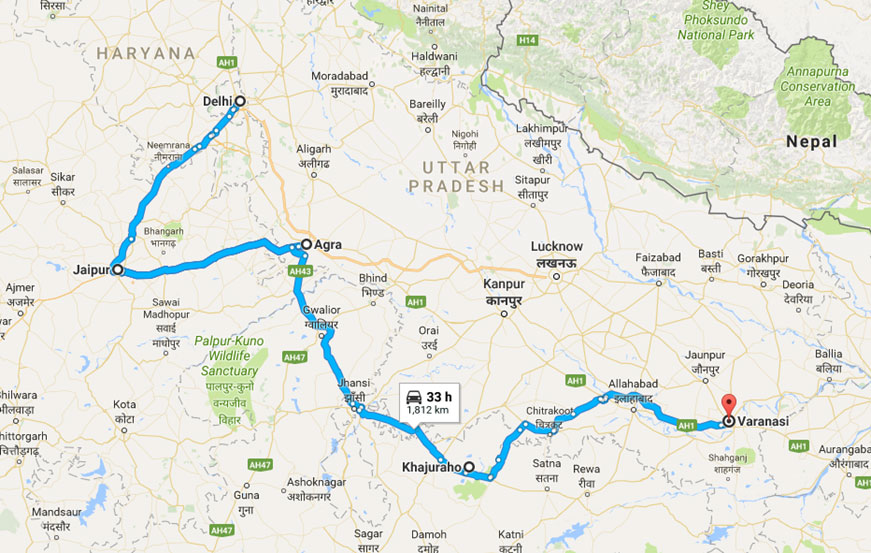
The following are the highlights of our trip. Also see Exploring Ed’s Photo Gallery for more pictures.
Delhi
Delhi and New Delhi
Delhi and New Delhi are often used interchangeably but are not the same. Delhi is the National Capital Territory (NCT) and has an area of 1,484 square kilometers (573 square miles) and a population of around twenty-five million. It is mostly urban, but not entirely. New Delhi is only thirty-five square kilometers (thirteen and half square miles), and one out of the eleven districts that compose the city of Delhi, and the capital of NCT.
In 1911, Britain announced the capital would shift from Calcutta to Delhi. They proceeded to build a new section in Delhi, which had been continuously inhabited since the 6th century BC and has been a capital of various kingdoms and empires. The new area was fittingly called New Delhi. It has many of the national government buildings of the British and today’s sovereign India.
What is the capital of India? Like many things in India, this simple question is not clear (“The Diplomat” Sept 29, 2016). “New Delhi” is the term that most often appears in the datelines of news items and about the government of India, both in India and in the rest of the world…But, in a way, this would be like calling the capital of the United States “Capitol Hill.”…the Indian constitution itself merely declares the capital to be the “National Capital Territory of Delhi” (239AA), and subsequently refers to the area as Delhi throughout the document. Colloquial usage in India, moreover, lends itself to calling the entire capital simply “Delhi.” It’s evident through conversations, casual usage in the media and in television (people almost universally say they are going to Delhi, not New Delhi).”
So, my vote is Delhi is the capital, but the omniscient Google says it is New Delhi.
Old Delhi
While not the oldest part of Delhi, Old Delhi (as it is known now) is a walled city founded by the Mughal empire in the 17th century when they decided to move their capital from Agra. It remained the capital until the fall of the Mughals to the British in 1857. For context, various Muslims group invaded India (including present day Pakistan) starting in the 8th century. The greatest builders were the Mughals, who were Turkish / Mongols people who descended from Genghis Khan. They were from the steppes of current Turkmenistan and ruled most of India from mid-16th century to the mid-19th century. Mughals is a variation of a term for Mongols.
For most of the Mughal era, Old Delhi was an opulent city of mansions, mosques, forts and other buildings. Today it is rundown with few parts of the wall existing and only four gates remaining of the original fourteen. It is also a vibrant and crowded wholesale and retail commercial center with many narrow alleyways.
The central area is Chandni Chowk (Moonlight Square). The market was once divided by canals (now filled in) to reflect moonlight. It also includes the Old Delhi Railway Station and the Red Fort, the residence of the Mughal emperors for the last two hundred years of the dynasty (pictured below).
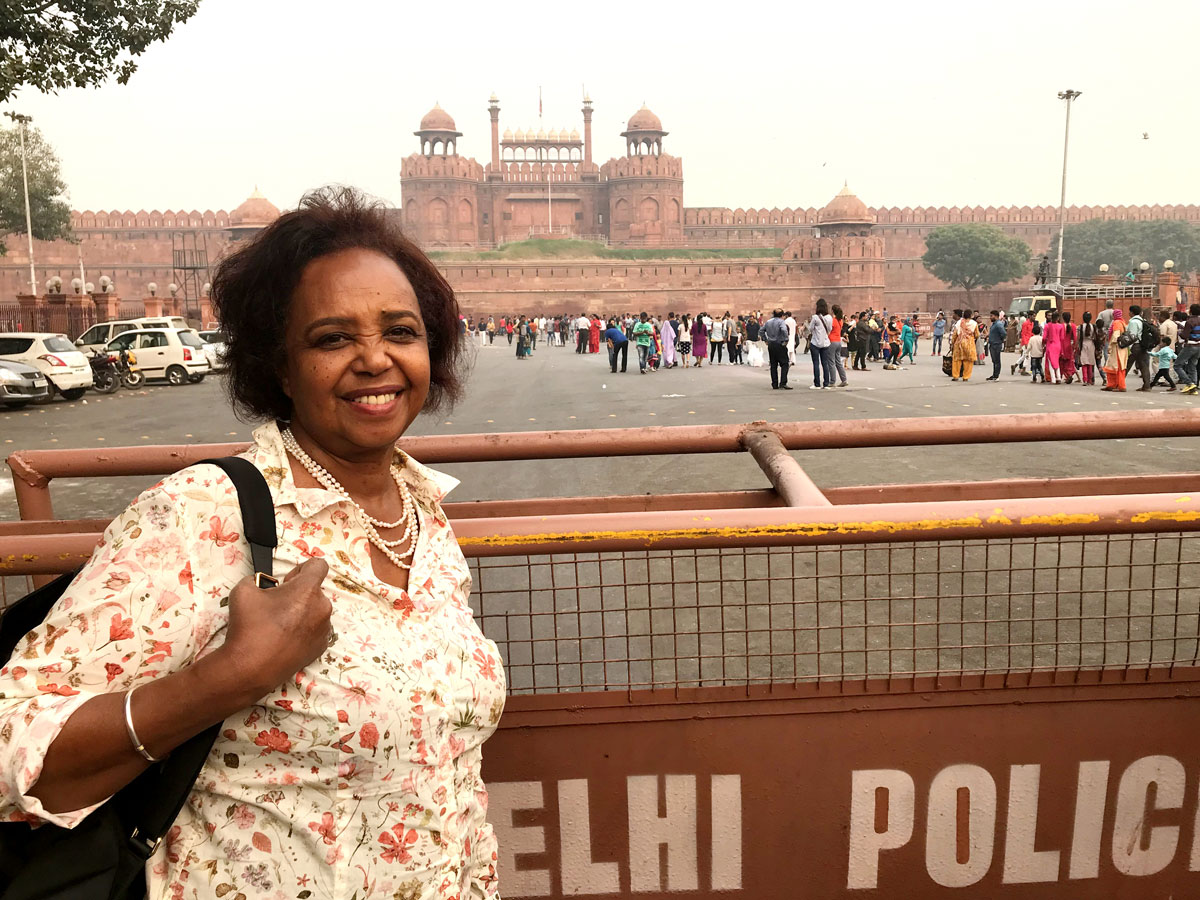
If you can handle unbelievably congested traffic, non-stop honking of horns, and swarms of people for a few hours, it is a place to visit to see the timeless vitality of India. While walking by the hundreds of stalls of merchants and food vendors, you must share your space with (and watch out for) trucks, cars, horse-drawn wagons, three-wheeled auto/cycle rickshaws, wheelbarrows, carts, cows and fellow pedestrians. The area has concentrations of stores selling related goods, including sections for jewelry, perfumes, spices, and cloth.
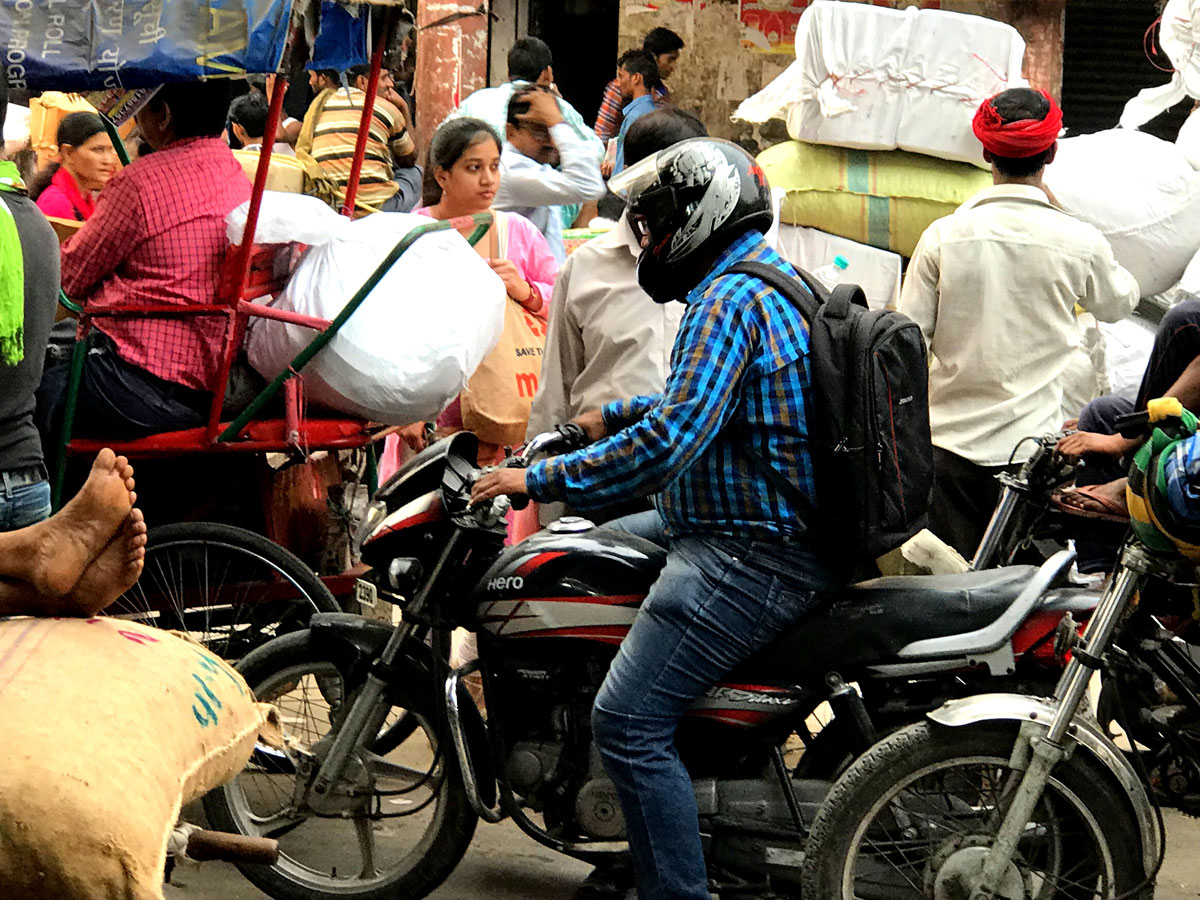

Like most places in India (and a lot of the developing world), outside telephone wiring is a tangled mess.
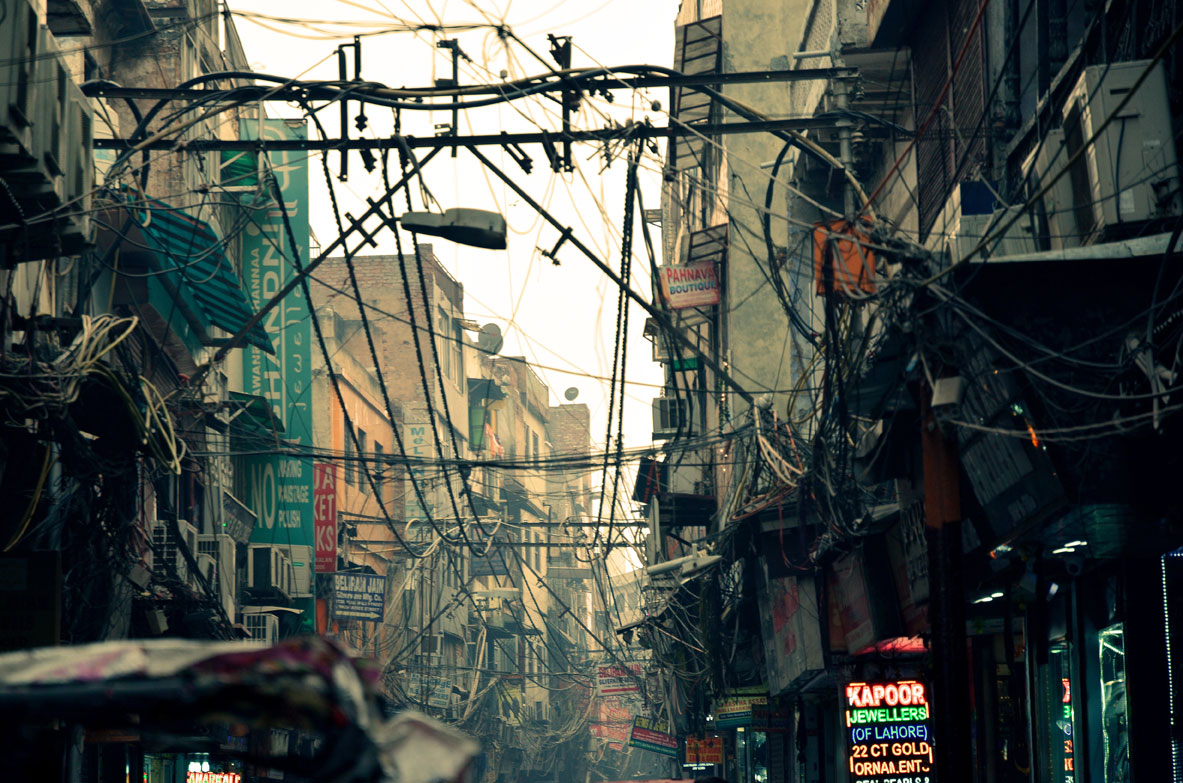
Akshardham Temple
The Akshardham Mandir (Temple) was built with Rajasthani pink sandstone and Italian Carrara marble. It is the centerpiece of the Swaminarayan Akshardham complex which was impressively constructed in five years without steel and opened in 2005. The temple sits on a square base with a continuous frieze with carved elephants in a variety of everyday activities, such as fighting off lions or being washed by their owners. The rest of the complex has exhibitions on Hindu and Indian culture, an IMAX cinema, a playground for children, water fountains used in a light show and attractive landscaping.
The complex was built in honor of Sahajanand Swami, who was an eighteenth-century yogi and ascetic and whose life and teachings brought a revival of central Hindu practices. Many of the financial supporters are from the Indian state of Gujarat, where there is another large temple built in his honor. While there were undoubtedly foreign tourists here, my impression is that Indians are particularly interested in this new temple. We saw many school groups on excursions there.
There are no phones, cameras or electrical equipment allowed, so I have no pictures except one taken from the road outside the complex. Note the haze from pollution (more on this later).

Lotus Temple
The architecturally-award winning Lotus Temple, of the Bahai faith, was completed in 1986 and has a capacity of 2500 people. The structure is made up of pure white marble in the shape of a nine-sided lotus, a symbol common to Hinduism, Buddhism, Jainism, and Islam. It is the last of seven major Bahai temples built around the world, including one in Wilmette, Illinois, near Chicago. While the lotus is not sacred to the Bahais, their scripture states that all Bahai structures should be nine-sided and circular.
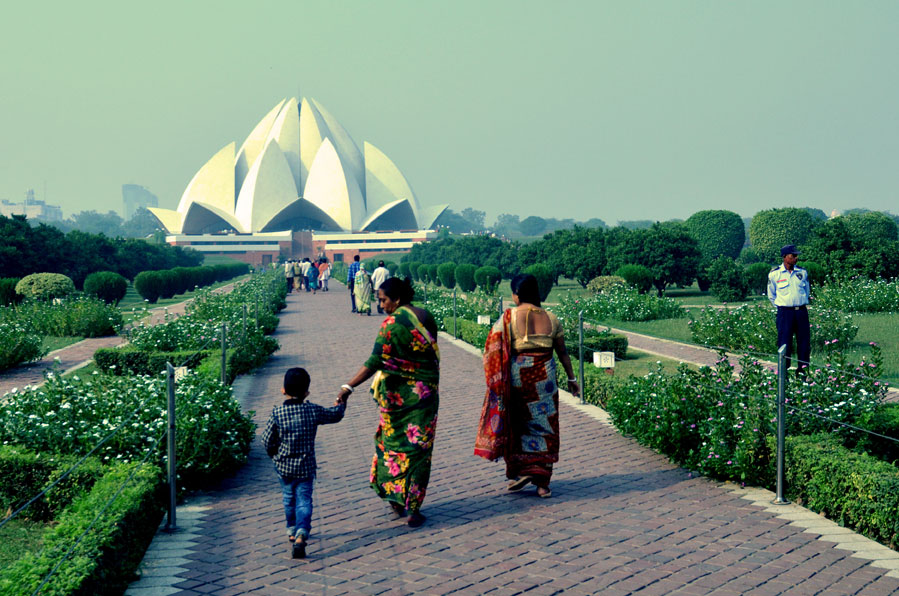
The Bahai faith is a religion teaching the essential worth of all religions and the unity and equality of all people. Established in Iran in 1863, it now has between five and seven million adherents, the most still in Iran.
The staff of the temple efficiently processes an average of over 10,000 daily visitors. Despite the vast number of visitors, virtually all remain quiet in the temple, making it an excellent place for contemplation.
Qutub Minar
Qutab Minar (Tower) is the tallest brick minaret in the world, with a height of 238 feet (72 meters). It was built using red sandstone and marble and leans slightly. It was started in 1193 by Qutab-ud-din Aibak, after the defeat of Delhi’s last Hindu kingdom, and took almost 200 years to complete. It has 379 steps but has been closed to tourist since a 1981 incident where forty-five people (mostly school children) died in a stampede during a power failure where some believed the tower was falling.
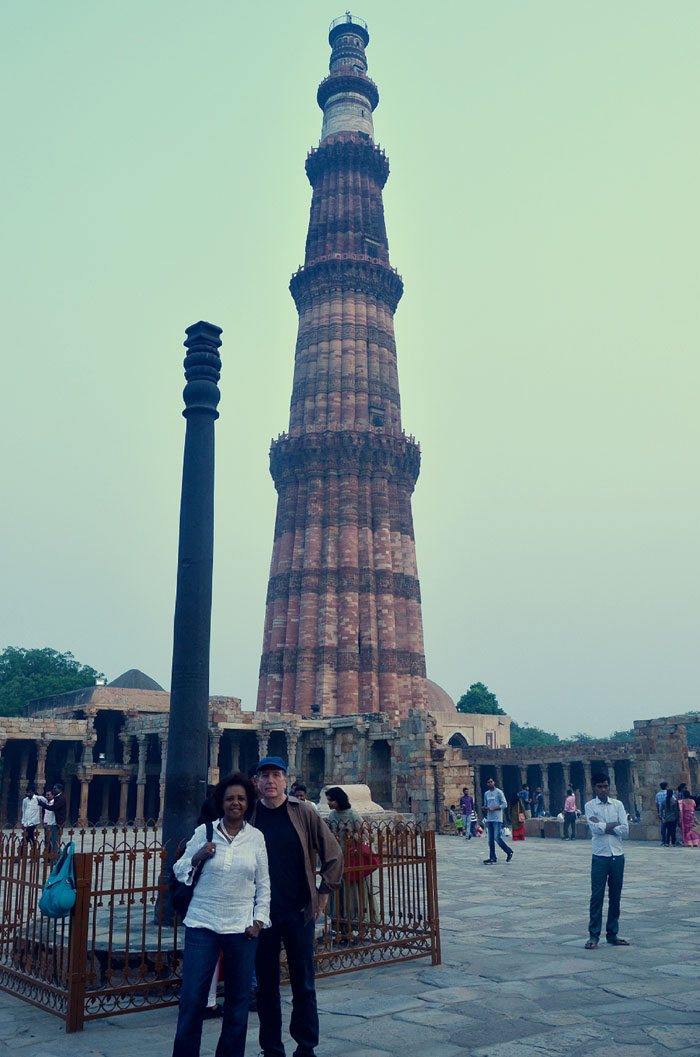
The complex has many other buildings including the Quwwat-ul-Islam mosque, the Ala-I-Darwaza gateway, the incomplete, wide-base Alai Minar, and the Hindu-era, rust-resistant Iron Pillar. The complex was built on the ruins of twenty-seven destroyed Hindu and Jain temples. The builders reused the material in many structures. The result is an amalgamation of Jain, Hindu and Islamic architectural designs.
Transportation
Our tour group was schlepped by a mid-size bus through the implacable traffic congestion of Delhi. It was always a slow, stop-and-start process. Being above the level of the cars and motorcycle provided a buffer of relief to the chaotic traffic. For the size of our contingent of foreign tourists, this was probably the only practical way of transportation. However, if we were alone, we would have the taken the fairly-extensive metro, which has stations next to most of the major tourist sites. It is inexpensive and much faster than driving.
Other Places to Visit
so much. From my research, if I ever go back, there are other places I would visit. I would try to go to these three museums: Mahatma Gandhi Memorial, National Museum, and the National Handicrafts and Handlooms Museum.
I would be interested in the following religious places to learn about their faith, as well as to view the architecture: Gurudwara Sis Ganj Sahib or Gurudwara Bangla Sahib (Sikh worship houses), Digambar Jain Temple, Laxminarayan Hindu Temple with no caste restrictions and Nizamuddin Darga, a mausoleum of a Sufi saint.
Non-religious places I would see include Rashtrapati Bhawan (House of the President) and a drive-by of Edwin Lutyens’ buildings including the grand, white bungalows (not the one-and-half story houses in California). These and other government buildings are in the Vijay Chowk area.
The Red Fort, the residence of Mughal rulers for 200 years, is a main attraction. If you are going to Agra and other places, you can see other vast Mughal complexes, so it would not be at the top of my list.
Delhi is a vast city, so you would think it would be easy to find performing art events. Partially because I had little free time, I could not find a good listing even after asking our local tour guides and hotel staff. On my own, I would pursue this, probably starting with Time Out Delhi.
Pollution
We have never encountered the level of air pollution that we were breathing in Delhi. It was uncomfortable in our first few days with a thick haze and a combination of smoky and vehicle-exhaust smell. When I washed my hair, I needed three times as much shampoo as usual.
When we returned and stayed overnight to take my flight to Katmandu the next day, it was incredibly bad, because visibility may have only been a mile, and the haze was so thick, you could imagine cutting it with a knife. While in the hotel, I looked outside and imagined myself in a spaceship on an alien planet with the glass pane protecting me from the toxic atmosphere. United Airlines suspended flights there for a few days because of the air pollution. I read that the air there was over seventy-five times above the World Health Organization’s safety levels and it was equivalent to smoking fifty cigarettes a day.
Many factors are causing the air pollution including industry with little environmental regulations, dust from construction and unpaved roads, a dramatic increase in motor vehicles (most with dirty fuel), nearby coal-fired power stations, burning of crops that remains after harvest in surrounding provinces and fireworks during the Diwali holiday. Cold weather, as when we were there, exacerbates the problem by trapping the air pollution.
There is not only air pollution, but madding noise pollution with non-stop horn honking and water pollution with unsafe-to-drink water and inadequate sewage for the city’s population. This is a dramatic failure of government in the country. It is taking years off the lives of residents by causing increases in strokes, heart disease, lung cancer, and many respiratory diseases. It is particularly devastating to children and can cause premature births.
There is an enormous human and economic cost caused by the pollution such as productive lives are shortened, societal and medical cost skyrocket, companies don’t invest, skilled people who have a choice tend to leave, and tourism declines.
Until the pollution decreases, I don’t see myself coming back.
Neemrana
Neemrana is a town roughly halfway between Delhi and Jaipur. The reason to stop there is to visit the five-hundred-year-old Neemrana Palace, which is now a hotel with seventy-two rooms, enjoy their excellent lunch buffet in an opulent dining room and stay for the night. Renovated in 1986, the fanciful structure is right out of a Harry Potter novel with twelve levels, towers, turrets, parapets, arches, waterfalls, winding stairs and hanging gardens.
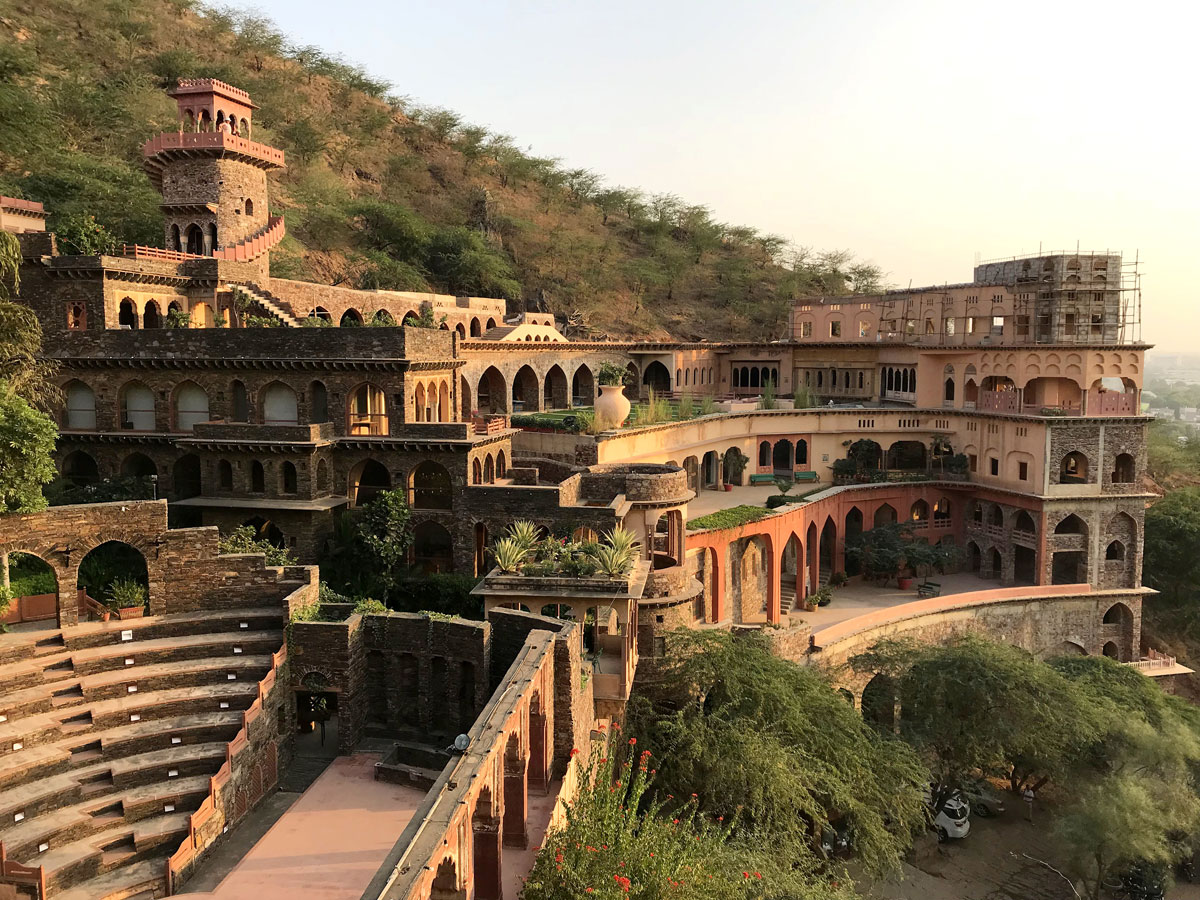
Jaipur
Overview
Raja Sawai Jai Singh II in 1727 founded the eponymous city of Jaipur (now the capital of the State of Rajasthan) and built the Royal family palace. Jaipur, designed in a grid system, has broad straight avenues, roads, and streets with uniform rows of shops on either side. Jaipur has nine sectors, symbolizing the nine divisions of the universe and surrounded by a wall containing seven gates. The Old City is known as the Pink City, because of the color of the sandstone of the buildings.

Short History of Rajasthan
Northern Hindu India (including Rajasthan), before and during centuries of Muslim invasions, was made of several warring states, which grew, shrank, disappeared and reappeared. They were usually ruled by families of the Rajput “warrior” caste or a clan who claimed to be Rajput but were not necessarily accepted as such.
Amer was founded by the Meenas who ruled certain places in Rajasthan till they were overpowered by various invading Rajputs. In 1037 AD, the Kachwaha clan (at the time not considered a Raiput and even now many do not recognize it as such) conquered Amer, which eventually became known as the Jaipur state.
The Mughals long had their sights on conquering Rajasthan and engaged in battles with the region’s states. Their strategy evolved into incorporating as many states as possible into the empire through marriage and allowing substantial local control and freedom of religion. In 1562, Amer Raja Bhamal accepted Mughal Emperor Akbar’s suzerainty and gave his daughter in marriage to him. His son Bhagwan Das and grandson Man Singh, the builder of Amer Fort, were given high military and government positions in the Mughal court. The Mughals were able to unite Rajasthan for the first time.
As the Mughal power waned, other Indian states and eventually the British controlled Jaipur and Rajasthan. Sawai Man Singh II was the last ruler of Jaipur until his death in 1970 in a polo match in the UK. His successor was his eldest son Sawai Bhawani Singh, who is the current head of the family.
City Palace
The City Palace is a complex over three-hundred-years-old that has been continually enlarged and modified. It mixes Rajasthani and Mughal architecture in its courtyards, gardens, and buildings. At the entrance of the Maharaj Sawai Mansingh II Museum, are sculptures of marble, royal elephants.
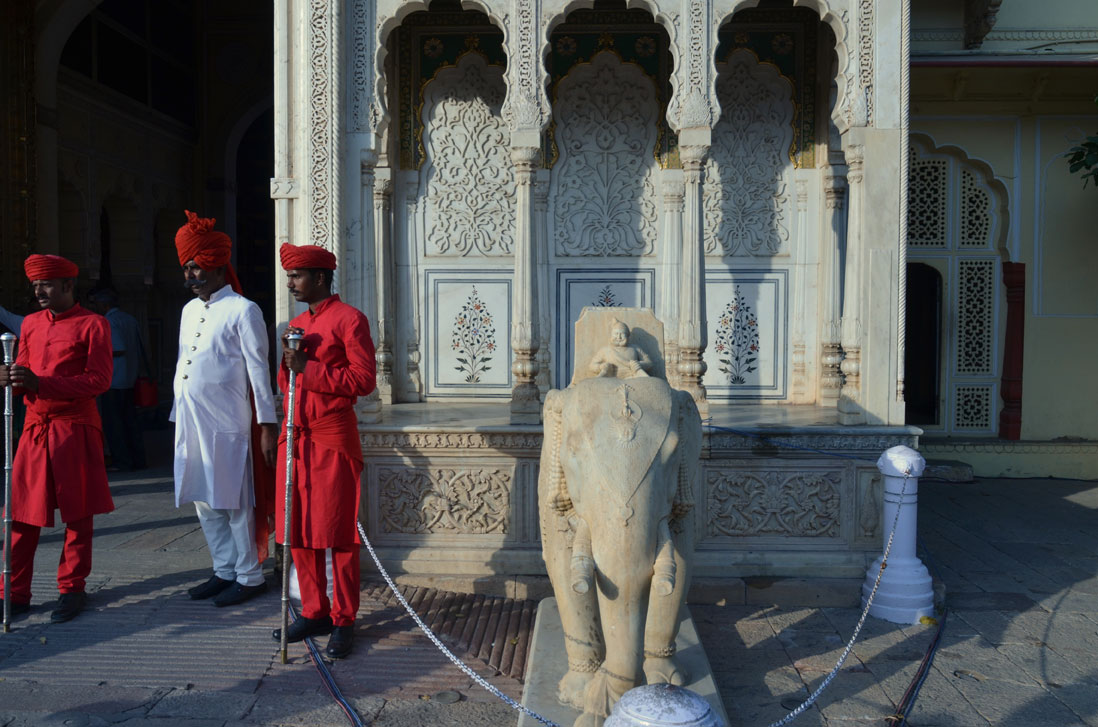
Mubarak Mahal, a multi-arched and colonnaded building containing a collection of royal costumes and premium shawls. The highlight to me was the display of bulky clothes worn by Maharaja Sawai Madho Singh I, a former ruler.
Jantar Mantar
The Jantar Mantar is an astronomical observation and UNESCO World Heritage Site built in the 18th century. There are twenty huge instruments made of stone, marble, and brass. The purpose of these instruments is to observe astronomical positions with the naked eye. There are five observatories built by Sawai Jai Singh II with this one being the largest, best preserved and according to our guide the most accurate.
The simplest is two sundials (Samrat Yantras), the largest measures within a two-second accuracy.
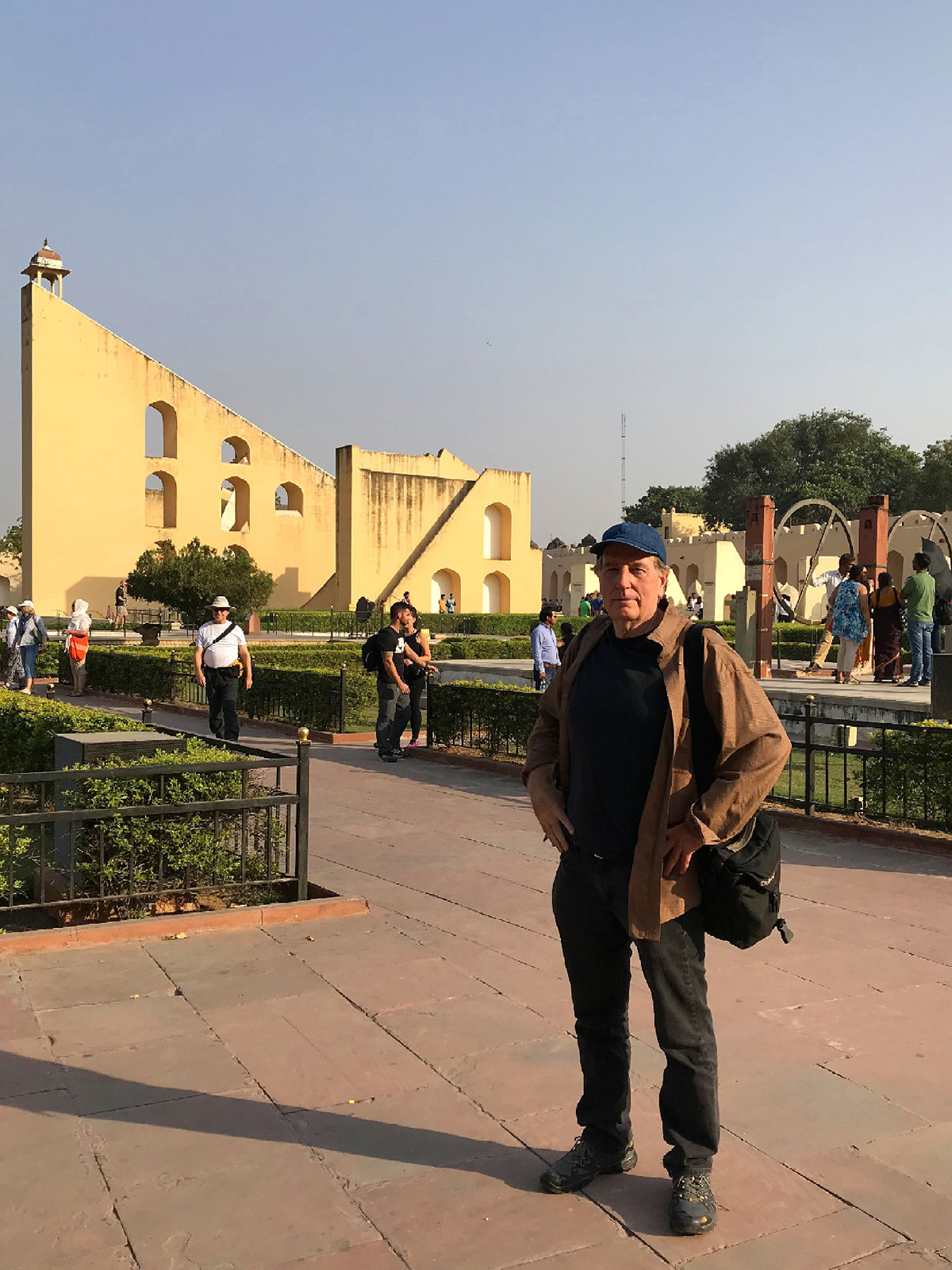
Others are the Unatansha Yantra which can determine the positions of the stars and planet at any time of the day or night and the Ram Yantra which determines the arc of the sun from horizon to zenith.
I found this place fascinating, and it tested how much high school astronomy I remembered. To understand how the instruments work, you need either an audio or personal guide. You can spend as little thirty minutes to probably three hours, depending on your interest and how much explanation you want.
Hawa Mahal
Hawa Mahal (Palace) is a beehive building, made of red and pink sandstone with over nine-hundred very small windows.
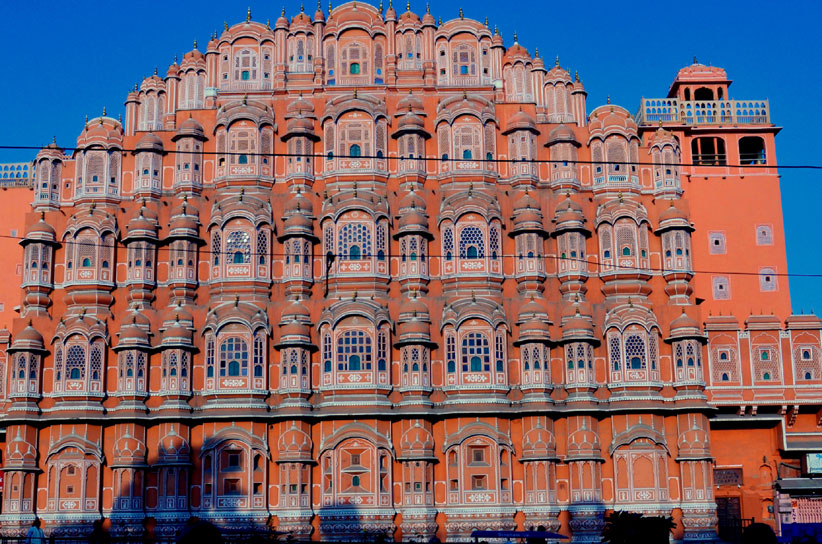
It was built in 1799 when it was customary for royal ladies not be seen by strangers. The construction allows the royal ladies to view the outside without being seen. There are no steps to the upper floors but ramps for the palanquin of the royal ladies. The building easily allows breezes to pass through it, thus the name Hawa (wind).
Amer Fort
Amer (or Amber) Fort (or Palace) sits on a high hill over the Maotha Lake, eleven miles from Jaipur.
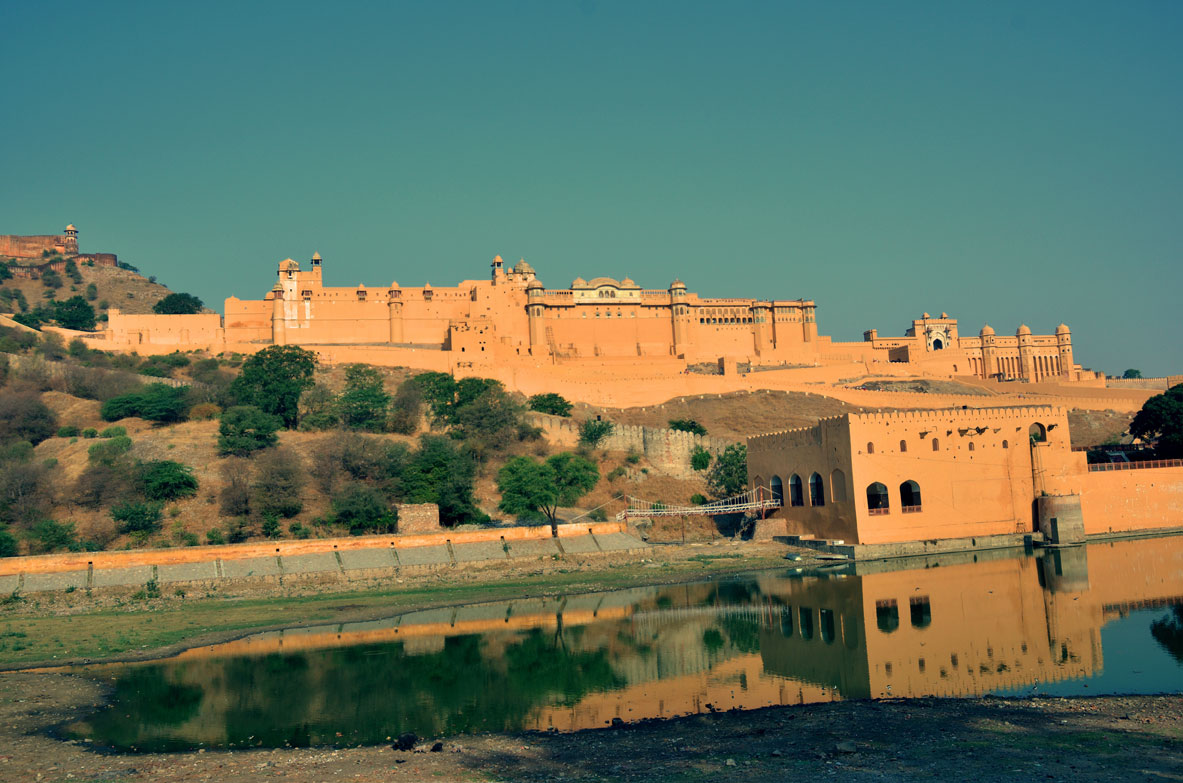
It was the first capital of the Kachwahas. It can be entered either through a narrow, steep and winding road through a residential neighborhood or by riding on an elephant. There is an ethical question of using these intelligent animals for this, especially as they are often overworked and mistreated. Now it is more regulated, and hopefully, they are receiving humane treatment.
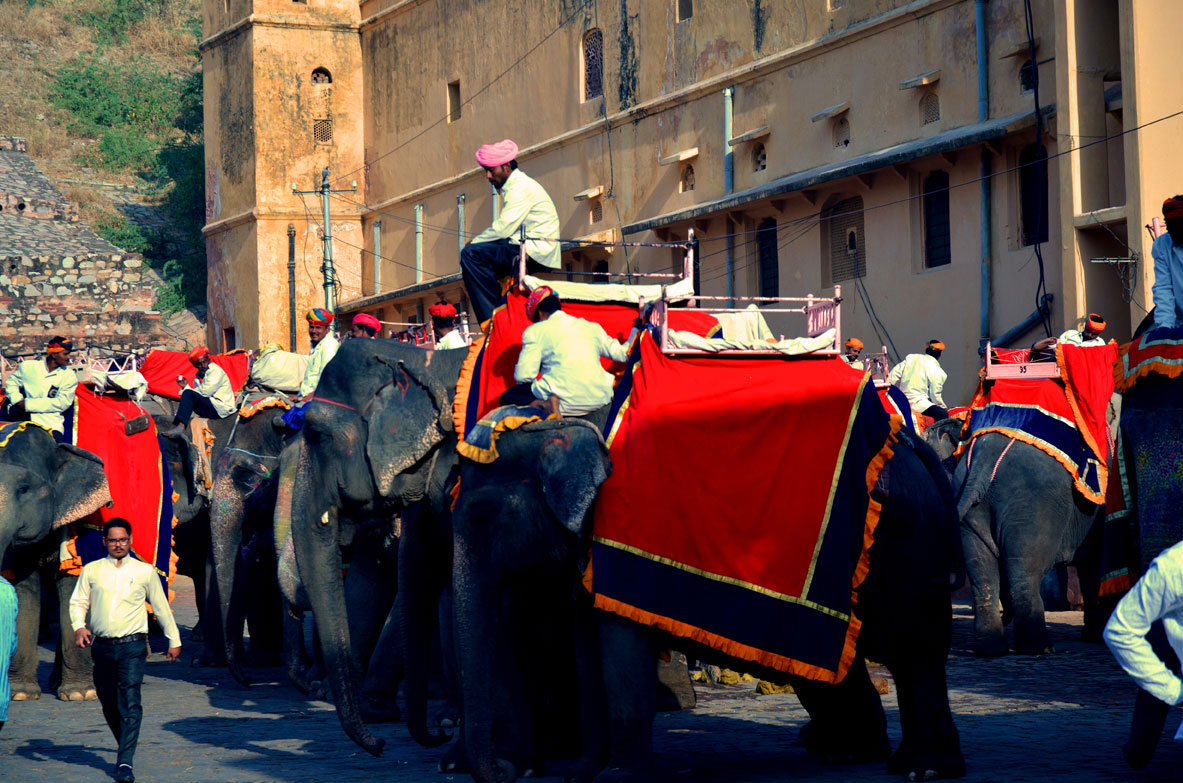
Raja Man Singh built this fort in 1592 and Raja Jai Sigh I expanded and renovated it later. It was built in red sandstone and marble with Hindu and Islamic architectural styles. The fort has four parts with their own entrances. The Sun Gate (Suraj Pol) is the main entrance and opens into the main courtyard (Jaleb Chowk). The place is vast and would take a book to describe all features. While this fort/palace was not built by the Mughals, it has similar immense size and grandeur of their structures.
Constructed of red sandstone and marble, the opulent complex is laid out on four levels, each with a courtyard. Sheesh Mahal, with thousands of mirrors, is one of the most interesting features of this fort.

One thing that caught my attention was the “Magic Flower”, a fresco carved out of marble. Each part is an animal (such as a cobra hood or an elephant trunk).

Dining
For our tour, most of our meals were buffets (where it is easy to overeat). One of the best restaurants we ate in was LMB in Jaipur, which instead served “thali”, food served on a round platter.
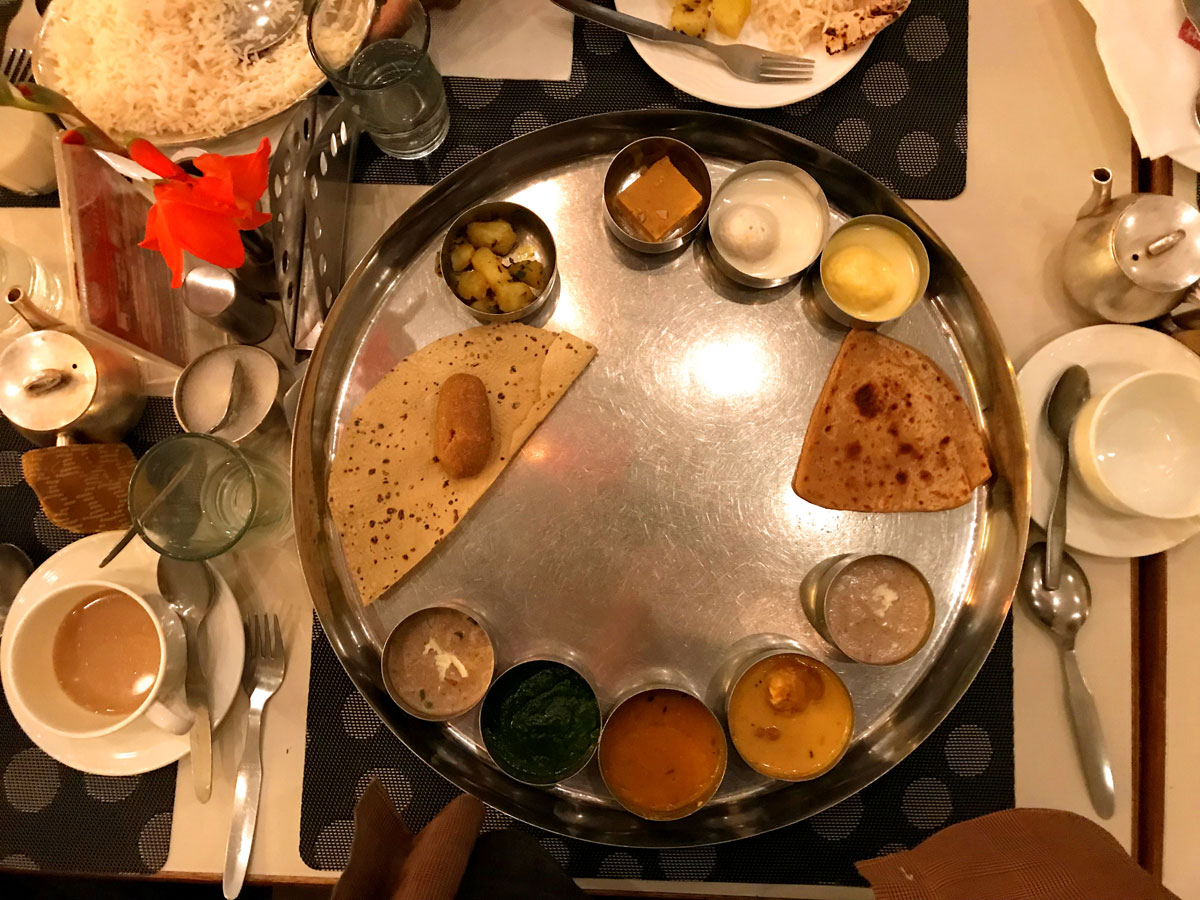
The restaurant was majority locals, unlike a few we went to which were mainly tourists.
Swastika
In many parts of Asia, you will see a swastika. In the original Sanskrit, it was the joining of “su” meaning ”good” and “asti” meaning ”to be”. It is a sacred symbol in Hinduism, Buddhism, and Jainism, with several related meanings including well-being, good luck, and acceptance. I noticed this one on the hood of a car outside the Amer Fort.
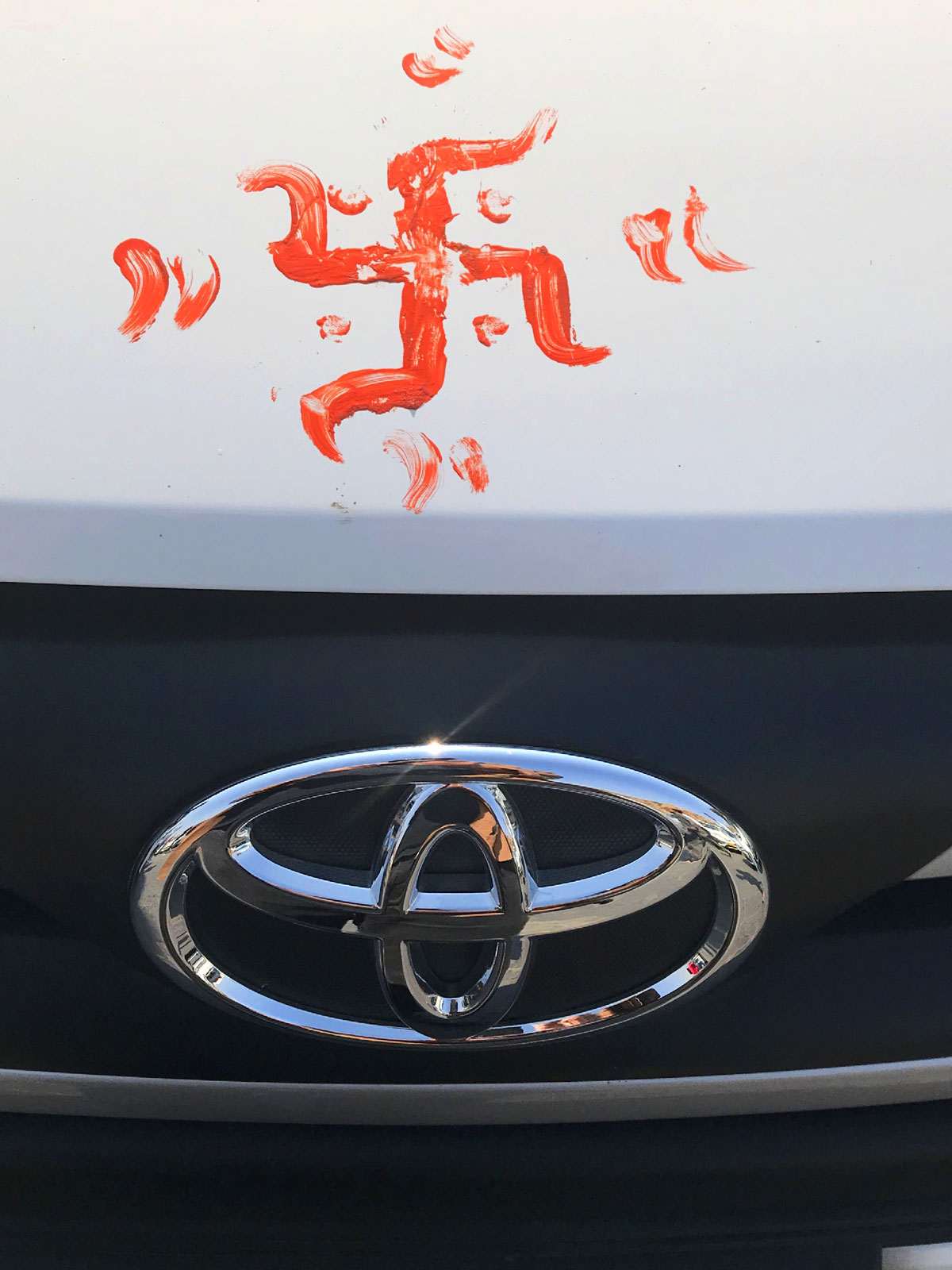
Through some unknown cultural exchange, Germanic and Viking cultures came to use it. It can be found in medieval churches across Europe. In the 1870s, when the amateur archaeologist Heinrich Schliemann was looking for the Greek city of Troy, he unearthed more than 1,800 instances of the swastikas. The German nationalist quickly claimed this was proof they were descendants of the Aryans, who spoke an Indo-European language and invaded northern India in the second millennium BC. It tragically became the primary symbols for the Nazis and, in the Western World, is associated with racism, barbarism, and genocide.
Chand Baori Stepwell
Chand Baori is a stepwell situated in the village of Abhaneri, about a third of the way to Agra from Jaipur. Stepwells are wells in which descending steps reach the water. Chand Baori consists of 3,500 narrow steps over 13 stories and is 100 feet (30 meters) deep and is one of the deepest and largest stepwells in India.
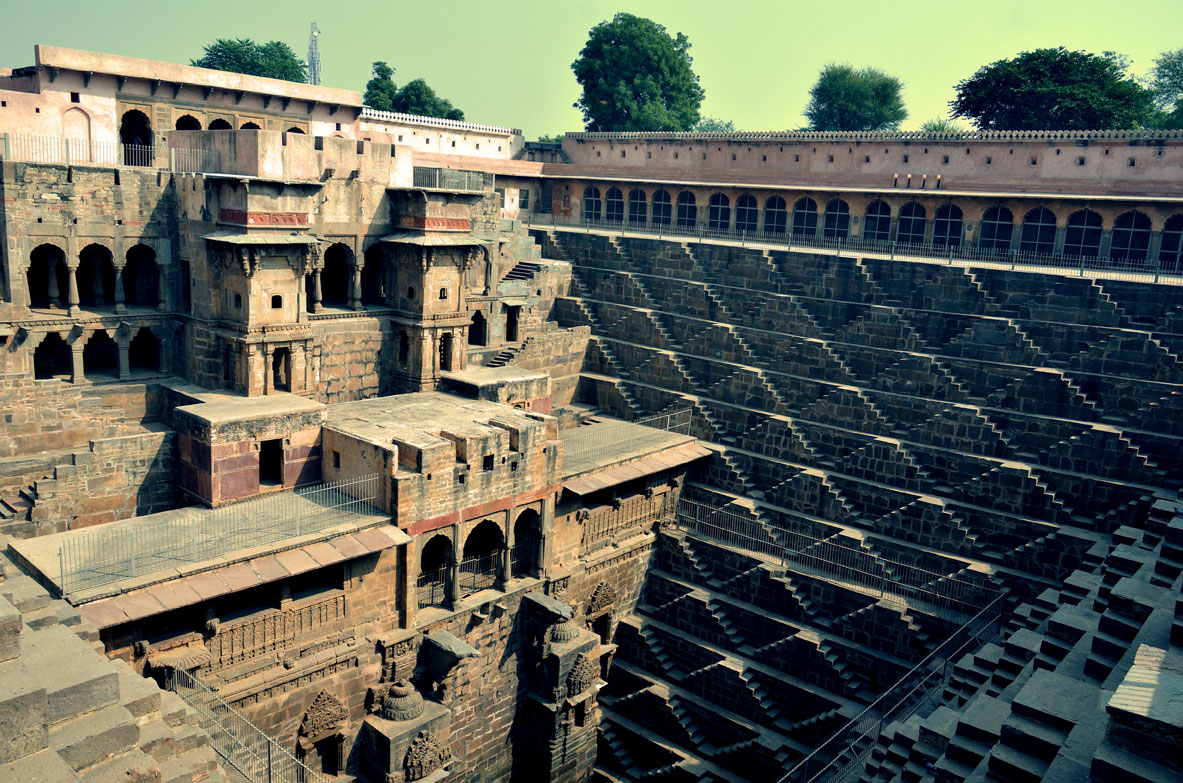
King Chanda of the Nikumbha dynasty built this between the 8th and 9th centuries to address the lack of water in this arid region. I was surprised to learn that it was used in the “Dark Knight Rises” (prison for Bruce Wayne) and other movies. The overall look of the place reminds me of an M.C. Escher drawing which I had a reproduction of in my college dorm room.
Fatehpur Sikri
Fatehpur Sikri is a kind of ghost town with a few thousand residents outside, surprisingly living life without focusing on hawking souvenirs to tourists. It is thirty-five kilometers (twenty-two miles) from Agra, and the city was founded in 1569 by the Mughal Emperor Akbar the Great. It was in the capital for a brief fourteen years and was abandoned after his death, probably because of the scarcity of water. The name comes from “fateh”, meaning “victorious” in Persian. Sikri was the name of the village which previously occupied the site. It is a UNESCO World Heritage site because it is an architectural wonder on a vast scale and one of the best-preserved complexes built by the Mughals. It is another superb example of Hindu structural elements incorporated into Mogul geometry.
Akbar had visited the Sikri to consult the Sufi saint, who prophesied the birth of a son. Akbar was so elated when a son arrived, he built the fort/palace with an incredible mosque and three palaces, one for each of his most important wives (a Hindu, a Muslim and a Christian).
Diwan-i-Khas, a square building with four metal bell-shaped-capped towers on each corner, is the hall of the private audience (although it seems too small to accommodate the emperor and his entourage). The most fascinating aspect is the internal central column, called the Lotus, with is a masterpiece of stone carving.

While there, we were entertained by musicians seated in the courtyard. I am not sure, but I think they were Sufi, a mystical sect of Islam. Of note, Indian music often uses a harmonium (pump organ), a Western instrument invented in 18th century Denmark.
Buland Darwaza (Gate of Magnificence) was built in 1601 AD by Akbar to commemorate his victory over Gujarat.
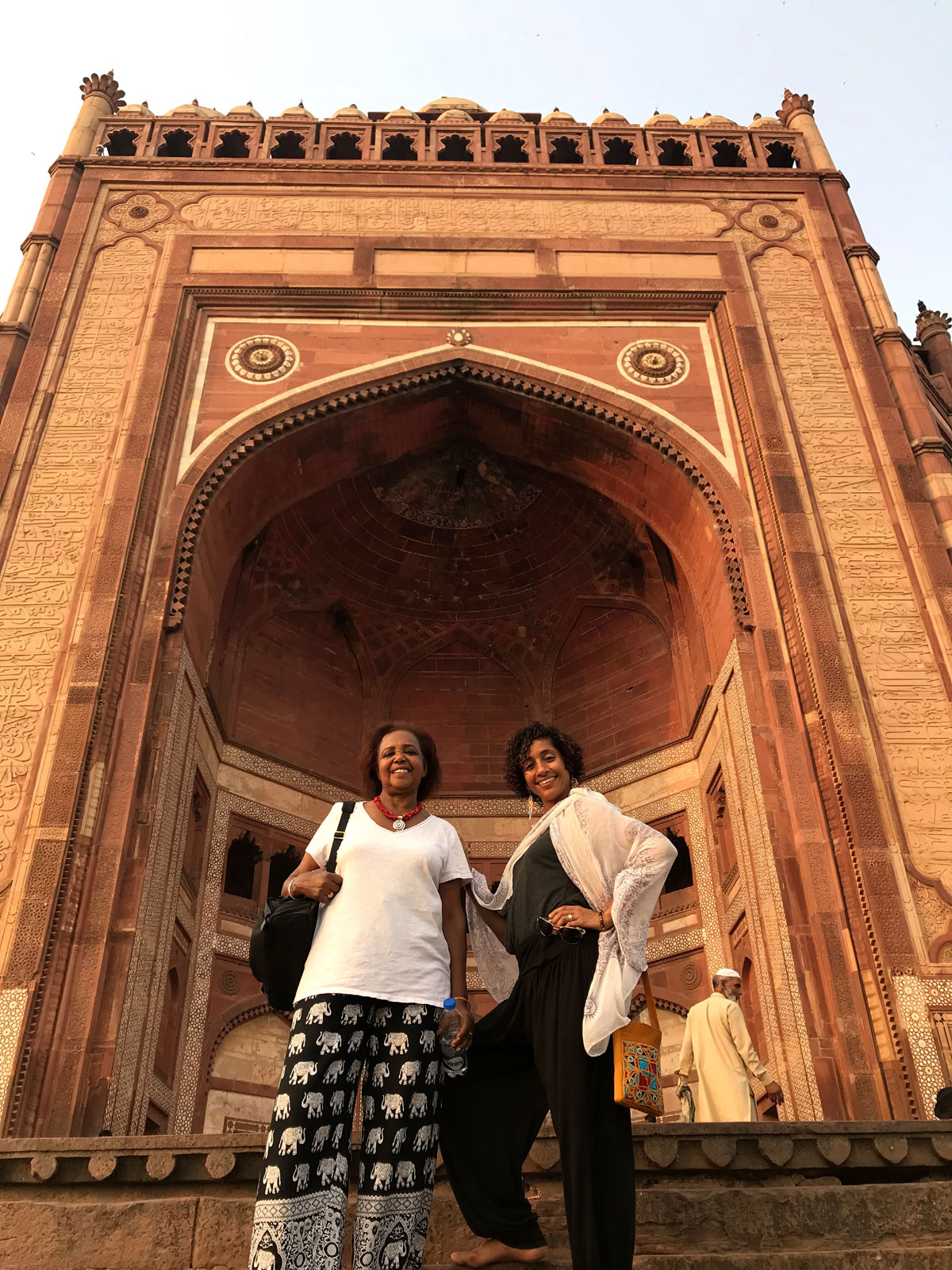
Buland Darwaza may be the tallest gateway in the world. It is forty meters (one-hundred-thirty-one feet) high, on top of forty-two steps. The gate is made of red and buff sandstone and decorated with white and black marble.
Agra
Taj Mahal
The Mughal emperor Shah Jahan took twenty years in the mid-17th century to build a white-marble mausoleum for his wife Mumtaz Mahal, a Persian princess who died giving birth to their 14th child. It is arguably the most beautiful building in the world and perhaps the most well-known. We stood in line at 5:30 am, as it opened at 6:00 am. There is always a crowd in front of the reflecting pond, which is front of the Taj Mahal. Because of atmospheric conditions (mainly pollution), it was very hazy but provided an interesting interpretation of the much-photographed structure.
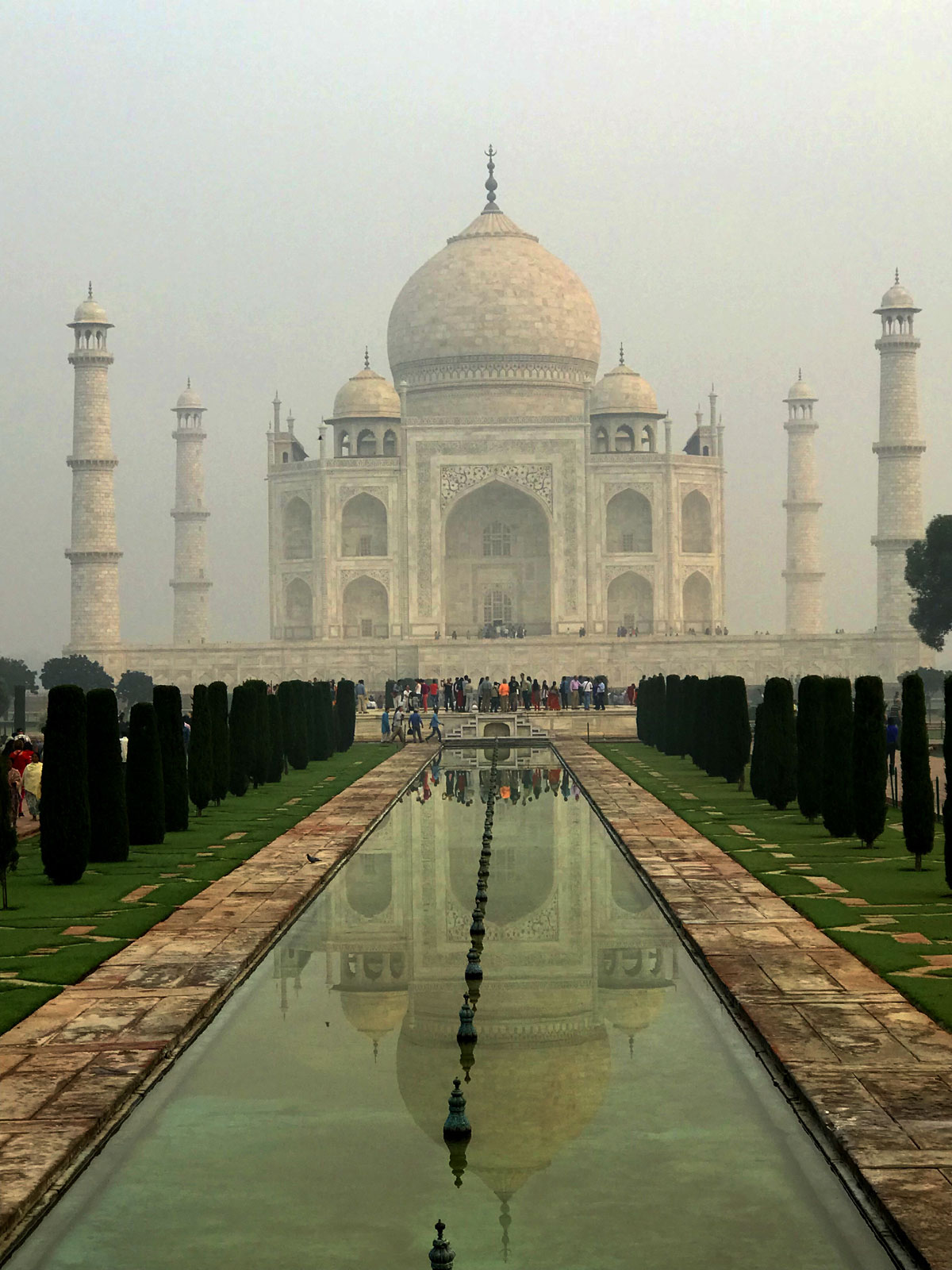
The Taj Mahal complex is a rectangle containing many buildings and structures, including entry gates, garden pavilions, mosque, a guest house (mihmankhana) with the mausoleum as the centerpiece. Visitors usually spend two or three hours there.
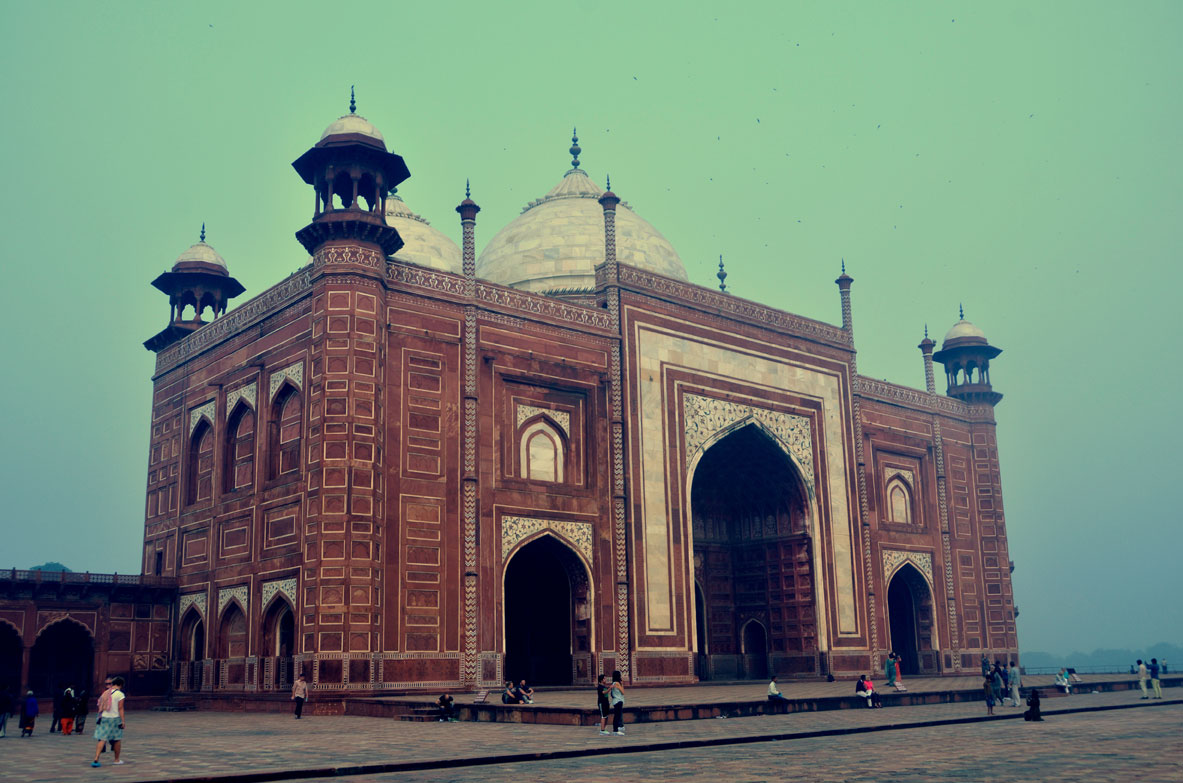
No one, except maybe a head-of-state accommodated by a private tour, will be the only tourist in the complex. There can be staggering 60,000 visitors in a day. But it is big enough, about one-seventy square meters (forty-two acres), that you can find plenty of space to appreciate the buildings.
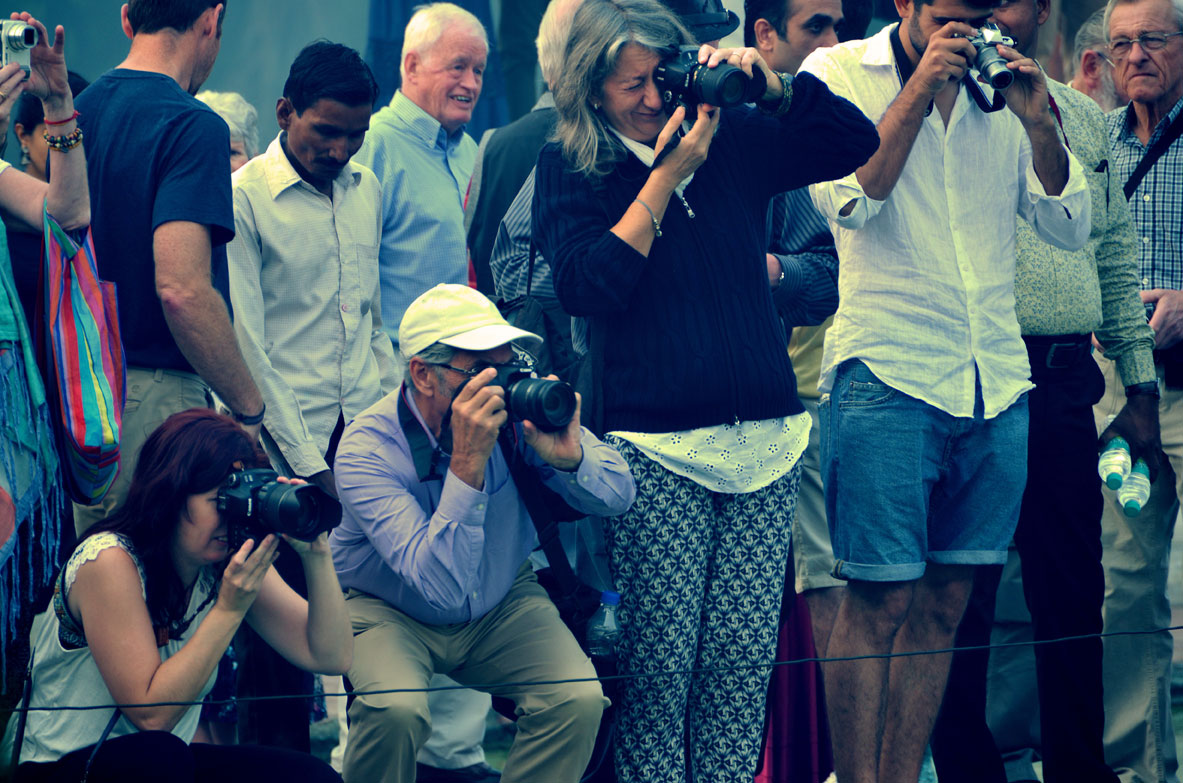
The romance of Shan Jahan and Mumtaz Mahal is portrayed in a very touristy, simplistic and melodramatic way in the “Mohabbat The Taj” at the Kalakriti Cultural & Convention Center. It is a lame story with dancers lip-synching and recorded music, but the dancing is elaborate and entertaining.
Agra Fort
Agra Fort is a UNESCO World Heritage Site. It is also known as the Red Fort (not to be confused with the Red Fort in Delhi). The fort has a semicircular shape with double, massive walls. It has many large sections. It is yet another mammoth-sized fort built by the Mughals starting in the mid-16th century. Considering all their buildings, I wonder how they had time and resources to govern and conquer new territories.
Jahangiri Mahal is the first building seen after entering the gate. It is a “zenana” (palace for women of the royal household) and was used mainly by the Rajput wives of Akbar.
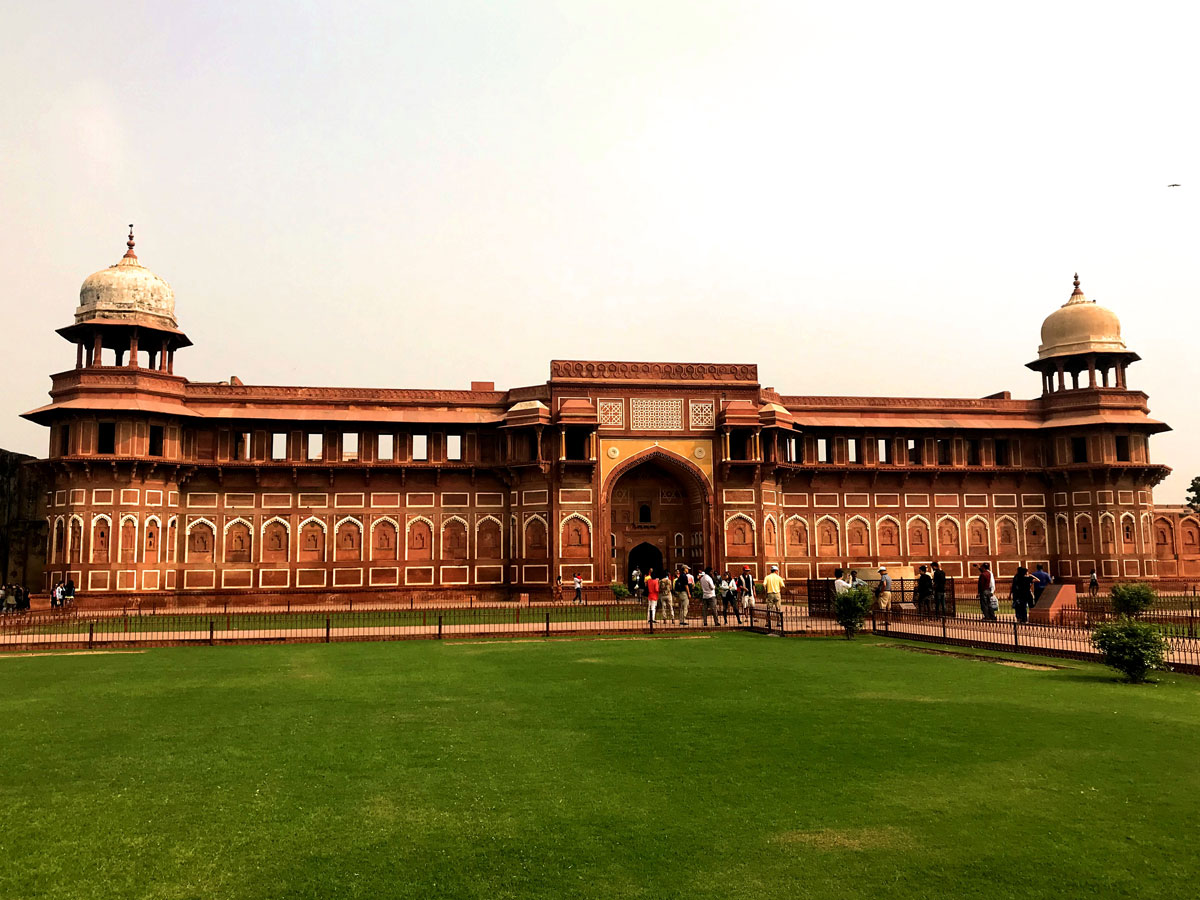
Khas Mahal is the most beautiful building in the fort and was built by Shah Jahan during the mid-17th century. It was the royal palace of the Emperor.
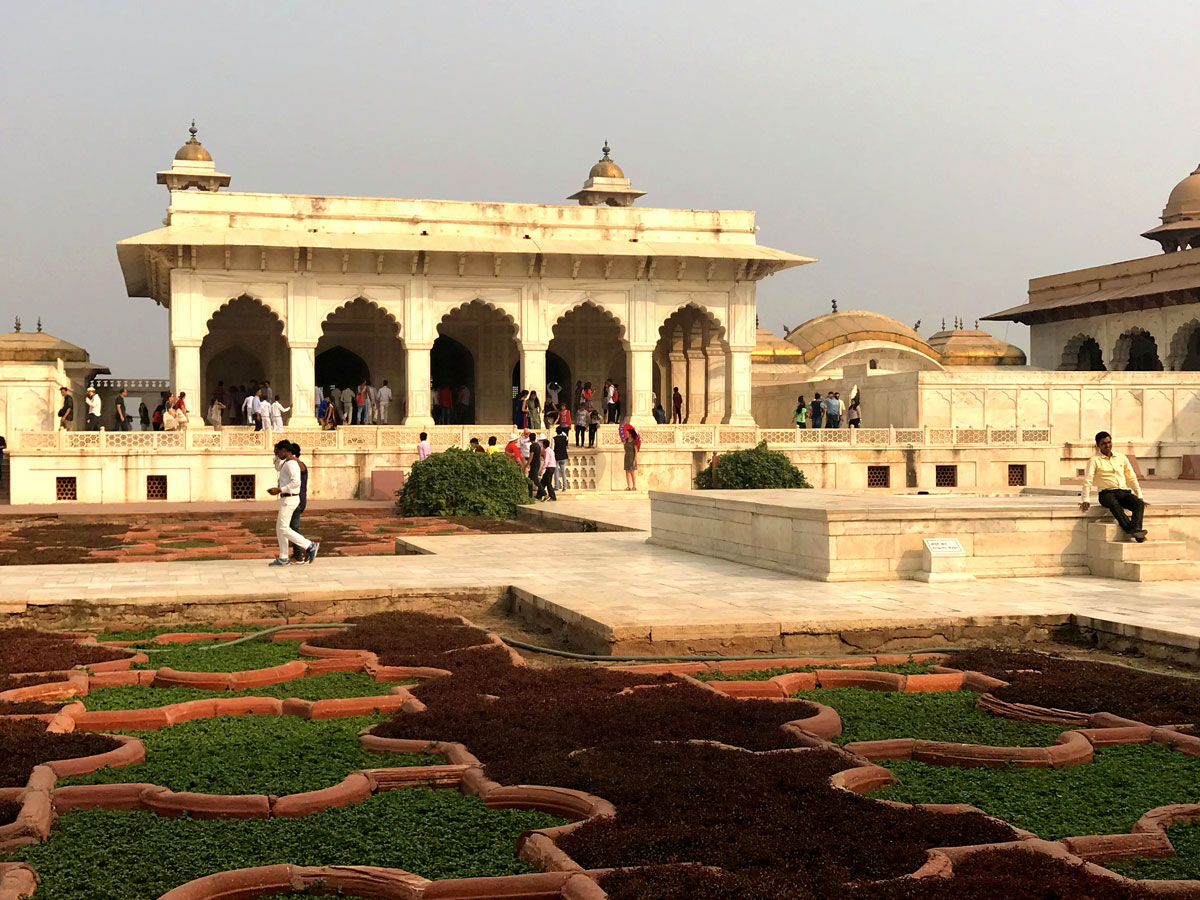
Aurangzeb (“Conqueror of the World”) was the sixth emperor of the Mughal empire and ruled for 49 years, extending the empire to nearly all the Indian subcontinent. When Shah Jahān fell seriously ill in 1657, Aurangzeb went to war for succession with his brother Dara, which he won and later executed Dara. However, his father had an unexpected recovery, and Aurangzeb imprisoned him in Agra Fort because he favored Dara. While imprisoned, albeit in luxury, in the last eight years of his life, he was able to see the Taj Mahal and remember his beloved wife.
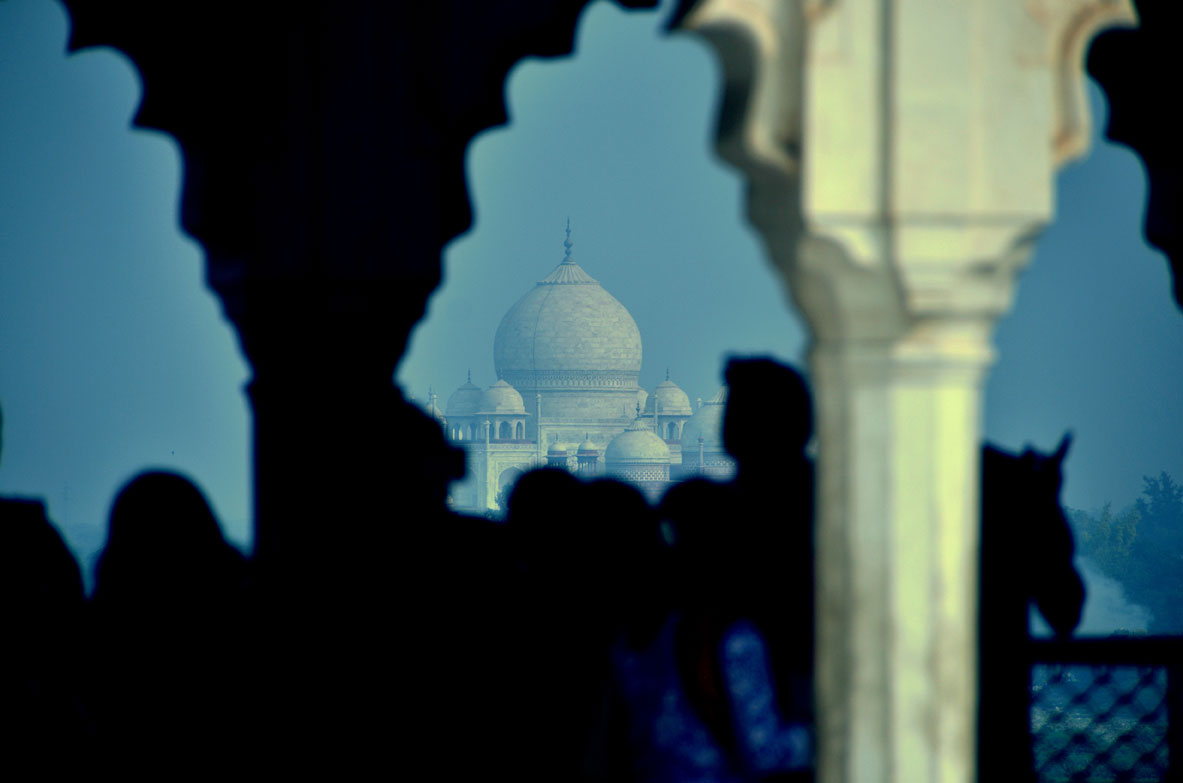
Elephant Conservation and Care Centre
On its website, the Wildlife SOS – India’s Elephant Conservation and Care Center states it “is a safe haven and rehabilitation center for over 20 elephants rescued from abusive and deprived conditions in captivity, as working or performing animals”. It is about an hour drive from Agra. A visit, which you need to schedule by email to [email protected] or call +91-9690011826, is an opportunity to meet and observe the largest land mammals. Everyone in my group thought this was one of the highlights of the tour.

There are many differences between Asian and African elephants. They are different species and genetically as close as humans are to chimpanzees. There are quite a few differences. African elephants are significantly taller and heavier and have fuller, more rounded heads (one dome versus two domes). African elephants’ ears are larger and like a map of Africa and Asian ears smaller like the shape of India. African elephants’ skin is more wrinkled, and they have more ribs. All African elephants, male and female, have tusks – whereas only some male Asian elephants have tusks. The African elephant’s trunk is visibly more heavily ringed and is not as hard as the Asian trunk. These are some of the most obvious, but there are several more differences.
Agra Train Station
We had been traveling everywhere by bus but, for our next segment, we went by the Shatabdi Express train from Agra to Jhansi, where we took a bus to Orchha and then to the Himalayan Institute. I am a veteran traveler and have seen quite a bit of poverty in the world. However, I am still disturbed by the deformed beggars aggressively begging at the train stations.
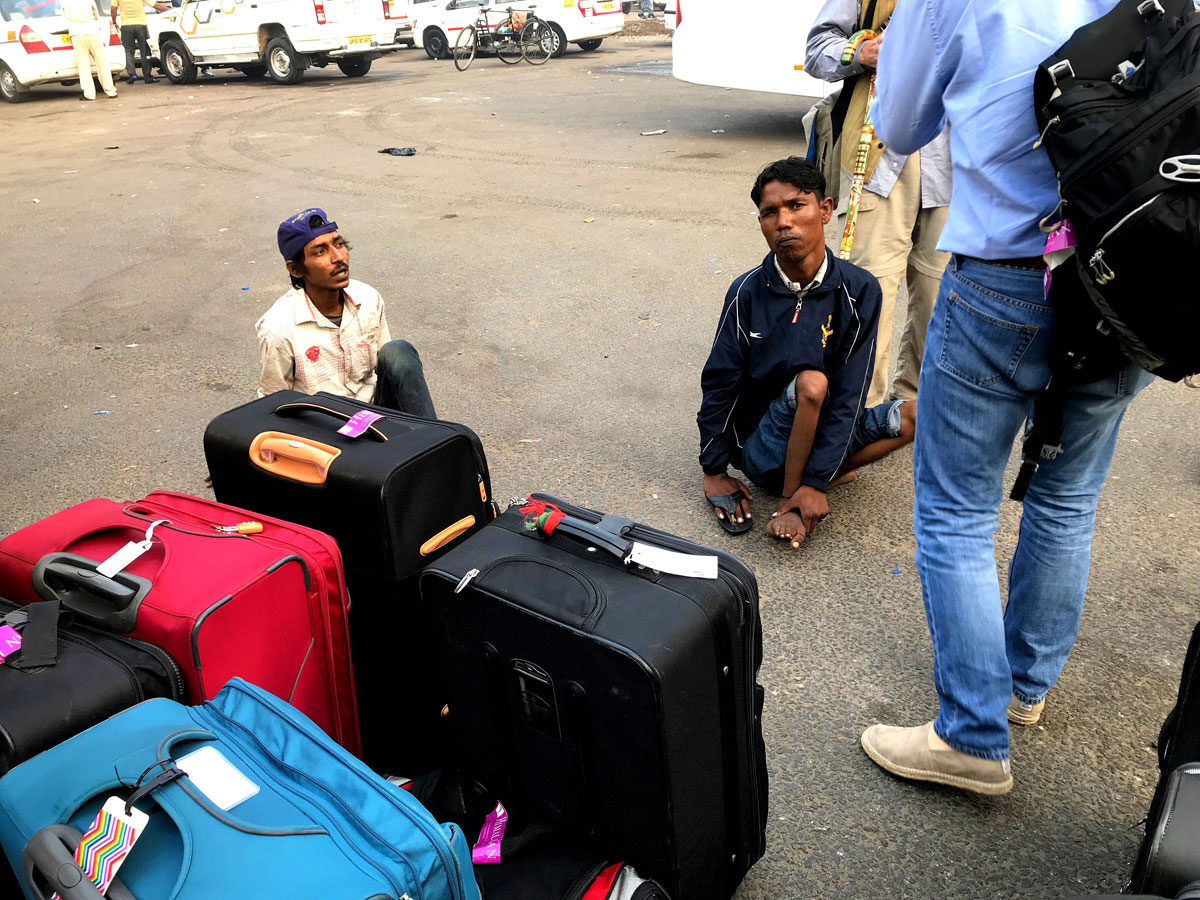
Some have no legs or arms; others have extreme elephantiasis of the foot or some other part of the body. However, do not give money to them, as they are being managed by others who profit from this degrading business.
Orchha
Orchha was the capital of the Bundela family, a Rajput clan of central India. They ruled several small states in the center part of India from the 16th century. Orchha has a fort complex with the usual battlements, palatial areas, temples and other structures. It is not at the scale of the Mughal forts I had seen, but is very interesting and feels more like a fort than a palace.
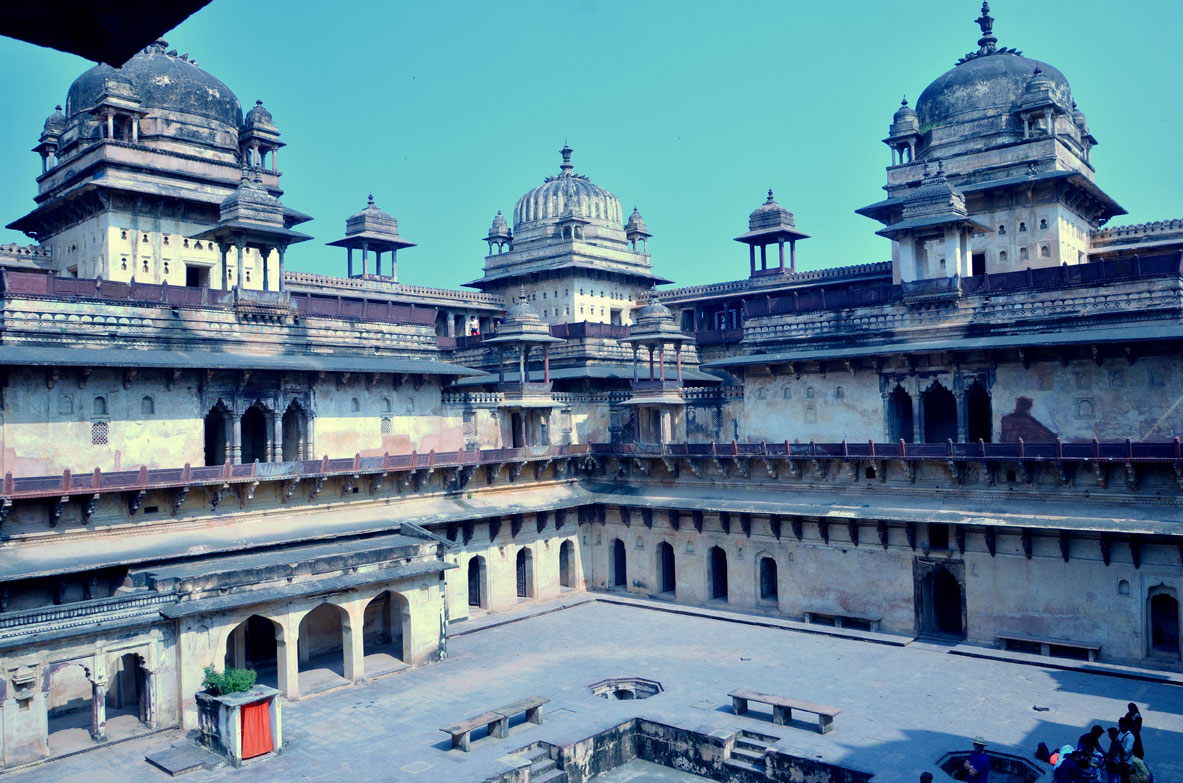
I will never forget this place, as this is where I had a tense encounter with a troop of Langur monkeys. They first confronted an Indian woman and her children. She was scared and retreated into a small room which they followed. She then threw coconut over the heads of the monkeys, who then left them for this snack. I then came close, and one snarled, jumped at me and scratched my pants. We both backed off. Be careful with monkeys!
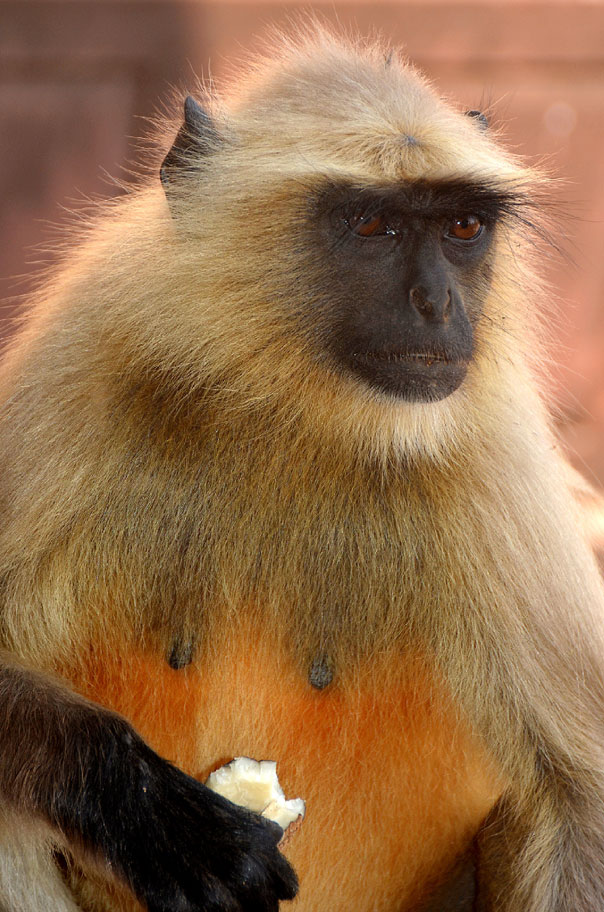
Himalayan Institute
Road from Orchha
It was about a four-hour drive from Orchha to the Institute on local two-lane roads, rather than the wide, divided highways we mostly had been taking. It was an excellent view of rural life in India. The drivers of trucks and buses, tilting one way or another because of inadequate suspension, are full of goods and people and are constantly dodging cattle, bicycles, motorbikes, and pedestrians.
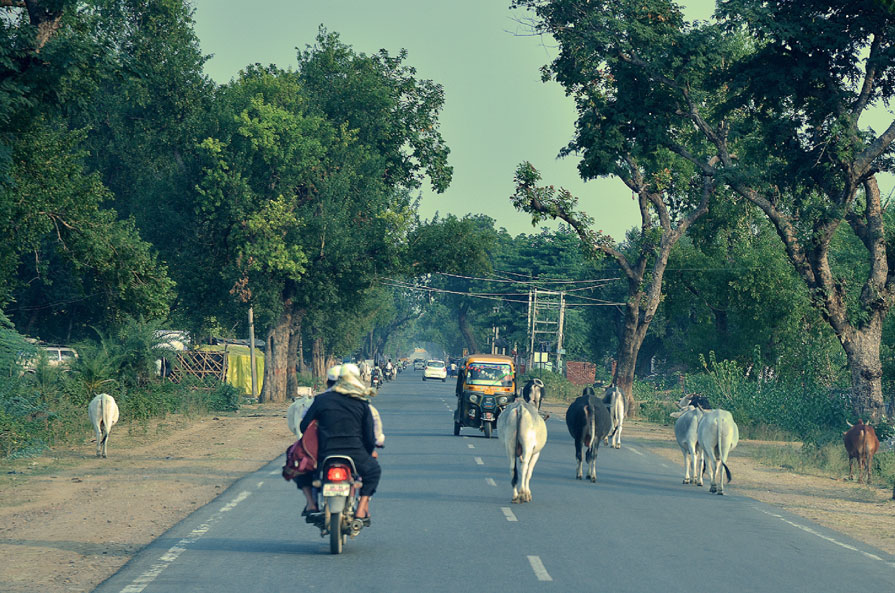

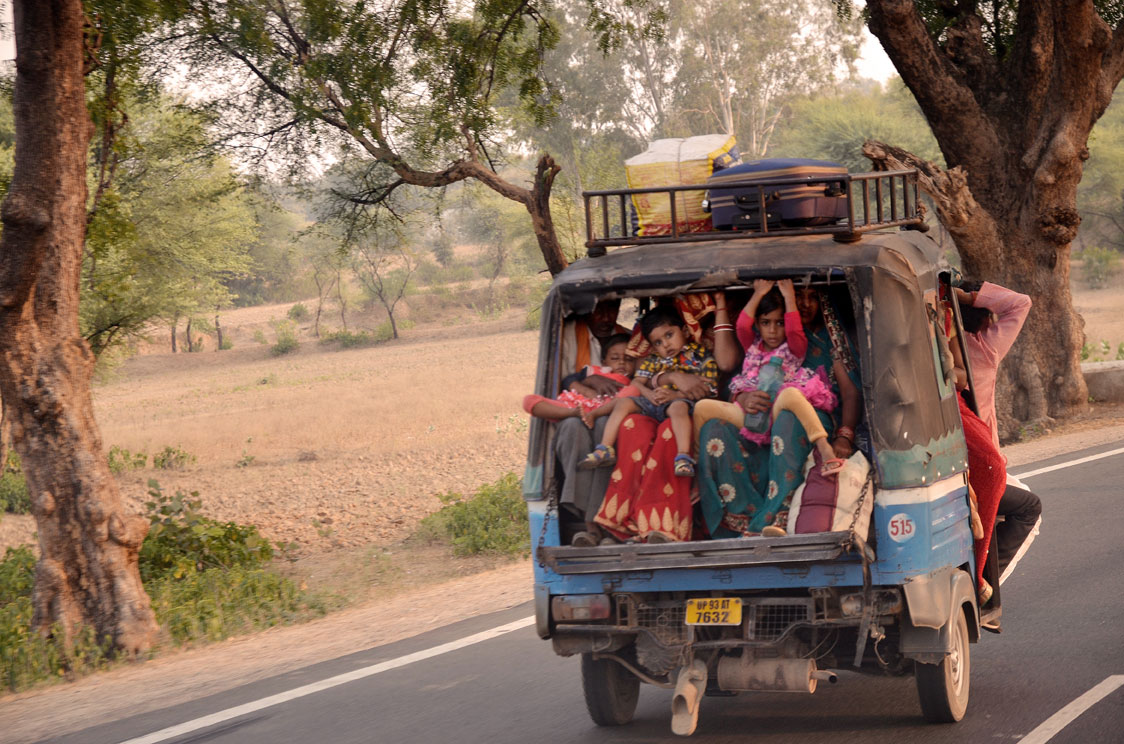
Himalayan Institute
We finally made it to our primary objective of the tour – five days of yoga in a peaceful venue. The Himalayan Institute’s mission is set forth on its website: “a non-profit international organization dedicated to serving humanity through educational, spiritual, and humanitarian programs.” This thirty-acre campus is close to Khajuraho and surrounded by hills. The community center, temple, pavilion, and residences have been constructed in the last three to six years.
When our group arrived, we met four other full-time residents of the Honesdale, PA campus who were spending time here. The only other people there were the workers, some of which lived on the campus.
A typical day started with a bell ringing at 5:30 am for chai (tea). At 6 am, recorded prayers in Sanskrit were broadcasted outside for fifteen minutes (I did not know what they meant, but they were soothing and facilitated mediation). At 7 am, there was a yoga session on the roof of the temple.
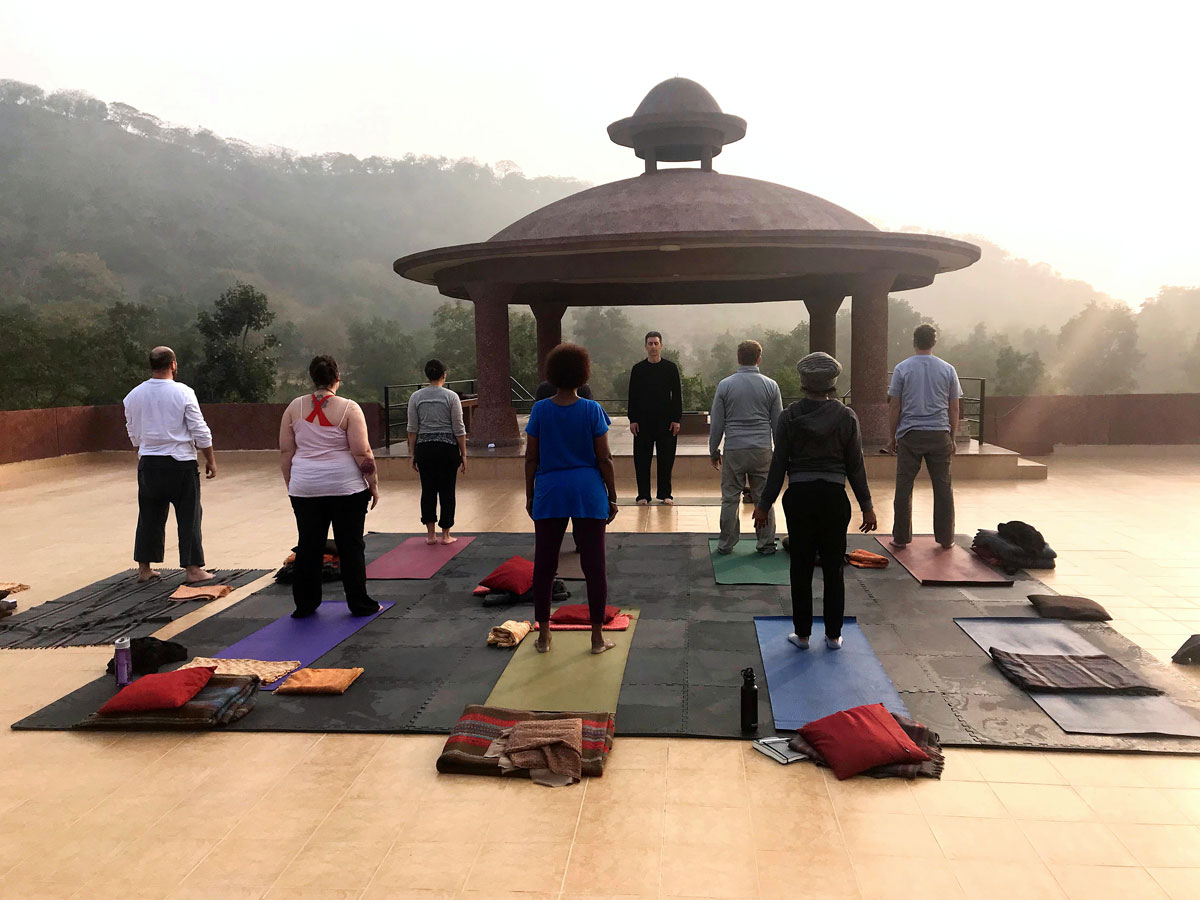
Then there was the 8 am breakfast which included cereal, yogurt, and Indian bread. At this point, some people would go outside the campus to hike in the nearby hills, take a taxi to Khajuraho for a massage, leave to shop or travel to the Panna National Park. If one was still around, a small vegetarian buffet lunch was served at 12:30 pm. At 3 pm, there was a pranayama (breathing) class in the circular pavilion.
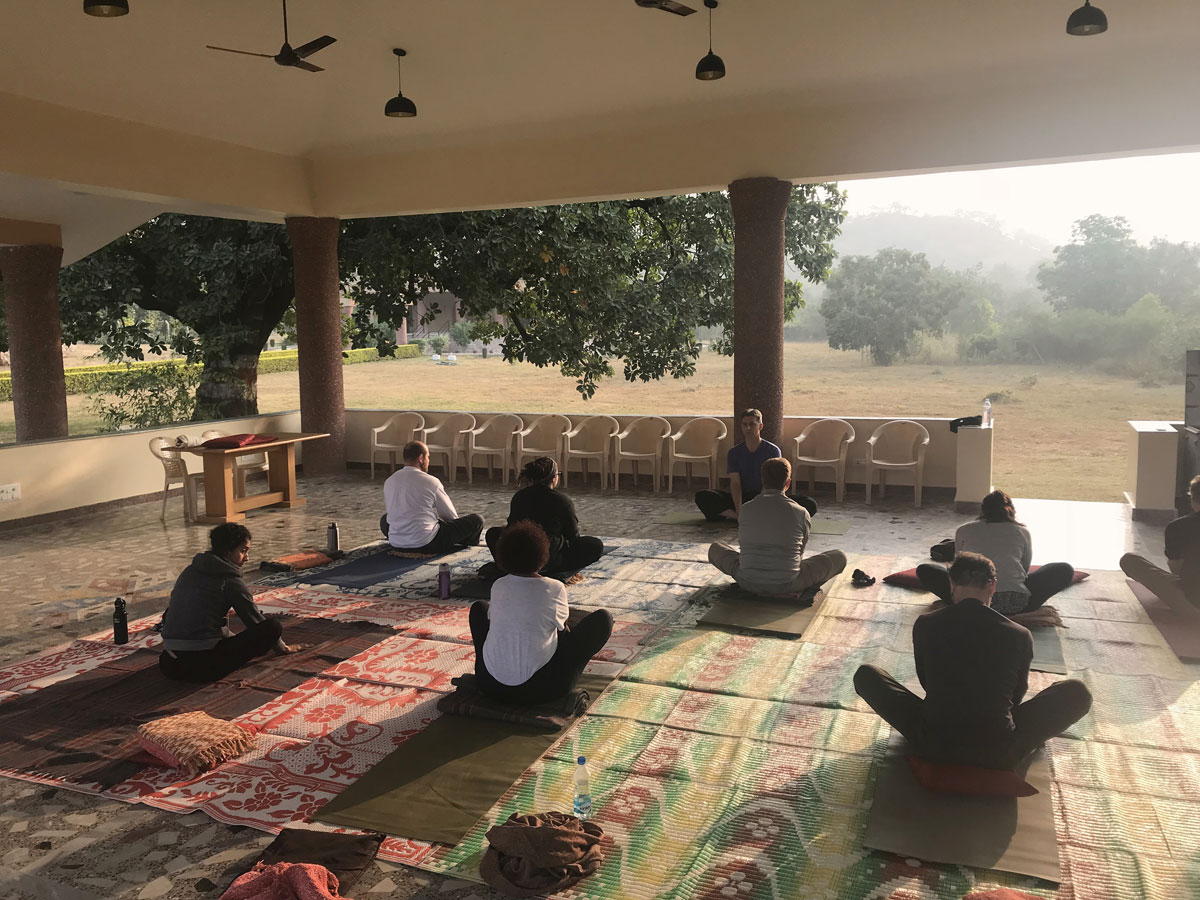
At 4 pm, chai was served again and at 6:15 pm, there was a modest vegetarian buffet for dinner. After that, some people watched lectures from Swami Rama, the founder of the Institute.
The rooms were large and had two beds and a modern bathroom. The Institute allowed Wi-Fi in the community center only from 7 am to 9 am and 4 pm to 7 pm.
At the end of our stay, we took a group photograph of our 11-person group (including Luke, the organizer), the Institute residents and the staff.
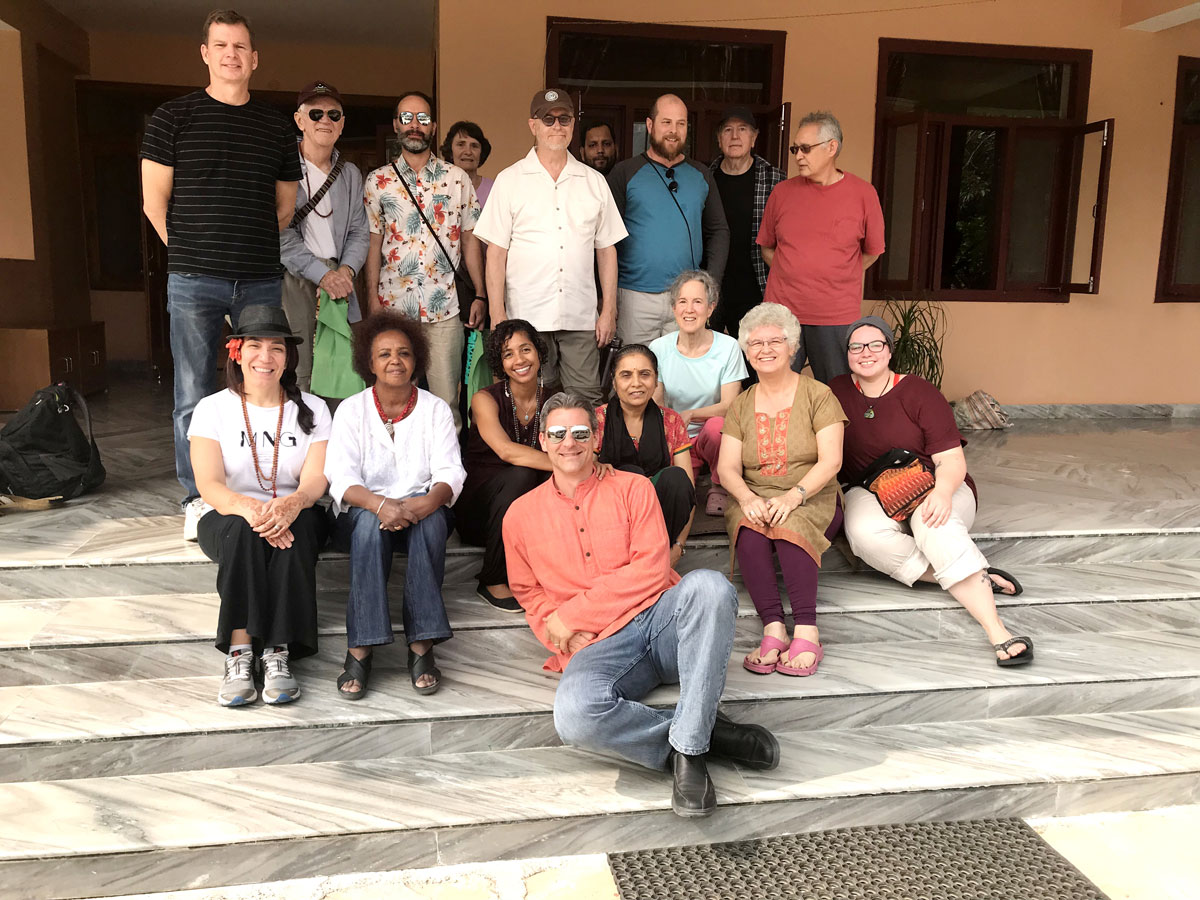
The routine was soothing, and everyone progressively relaxed after many days of intense Indian travel. The yoga and pranayama sessions were calm and stressed proper positioning and breathing, rather than aerobic activity like vinyasa flow classes in the US. Because of the activity and vegetarian food, most people shed the extra pounds they picked up at Indian Restaurant buffets.
Panna National Park
Panna National Park is about sixty kilometers (thirty-six miles) from Khajuraho. The park is full of Asian antelopes, deer, monkeys, reptiles and hundreds of bird species, including peacocks and eagles. It also has tigers, but they are seldom seen. Five of us from the Institute spent a couple engaging hours touring in a jeep. One of the most interesting sightings were the Langur monkeys, which I encountered previously in the Orchha Fort.
The terrain is savanna and the climate tropical with sweltering summers. In November when we were there, it was cold in the morning, but warmed up as the day progressed.
Khajuraho
Khajuraho Temples
The temples are most well known for their erotic sculptures carved into lofty sandstone and granite temples. It is believed there were eighty-five initially, but now only twenty-five are standing.
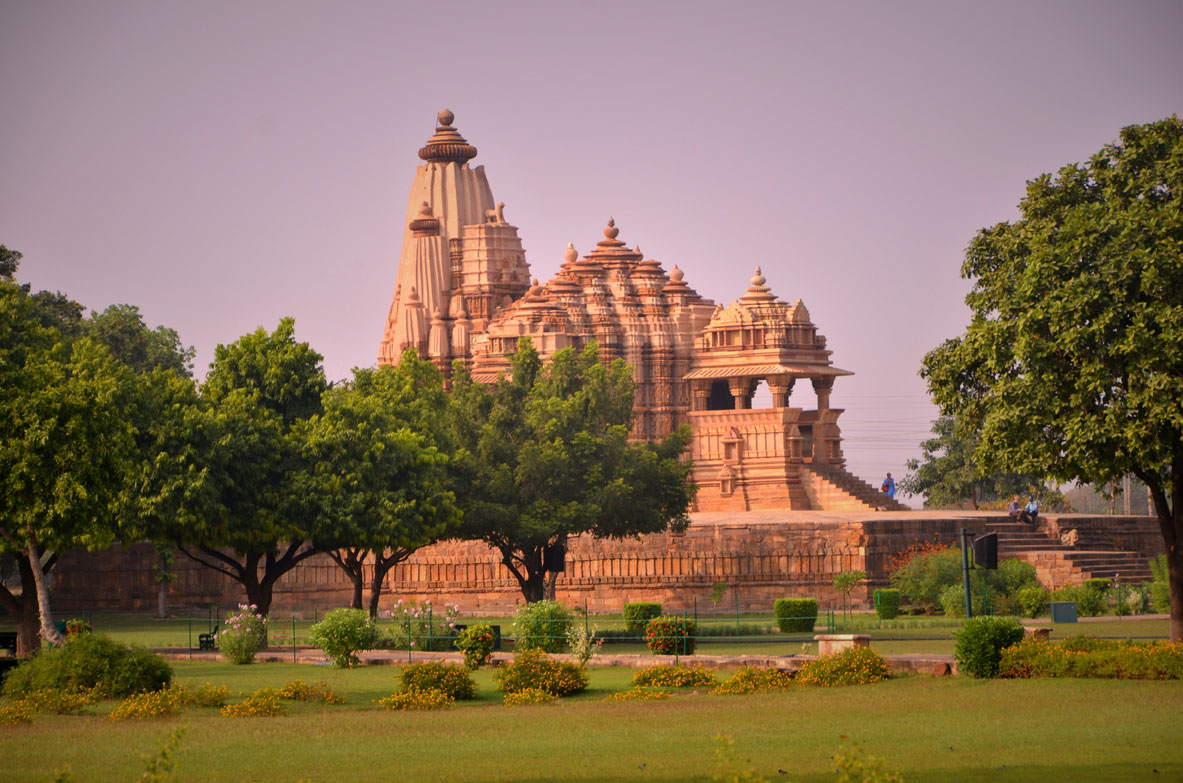
These temples were built by the Chandella, a royal dynasty in Central India between the ninth and thirteenth centuries. After the fall of the Chandella dynasty, many structures were destroyed or defaced by Muslim invaders. Afterwards, they were eventually covered by vegetation and forgotten except for few who lived close to their remote location. They were re-discovered by the British in the 1830s.
While there are many erotic carvings, the beauty is the exquisite workmanship depicting sinuous bodies and expressive facial expressions.
While today’s India is relatively conservative, these temples show how civilization’s views are always evolving on sexuality and other social issues.
Khajuraho Town
This small town of 20,000 inhabitants is a welcome relief from India’s megalopolises. I have a few hours to walk around and observe the flow of local life.
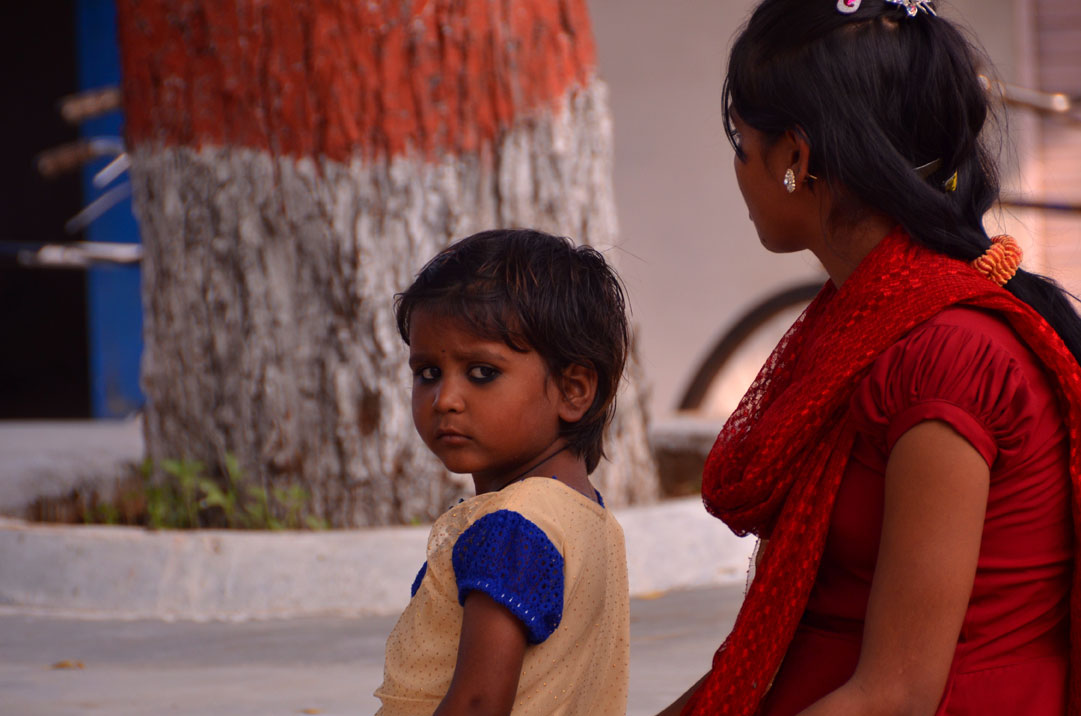
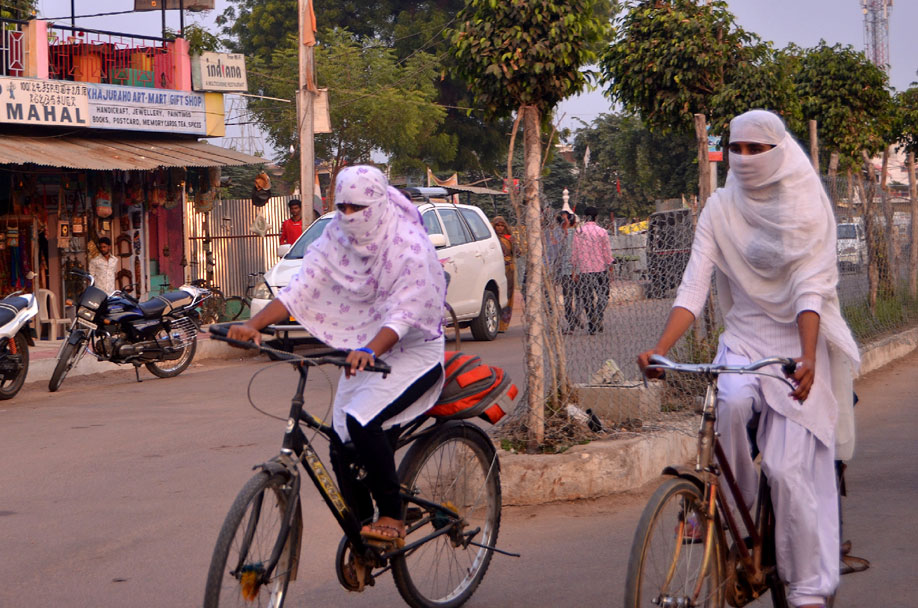
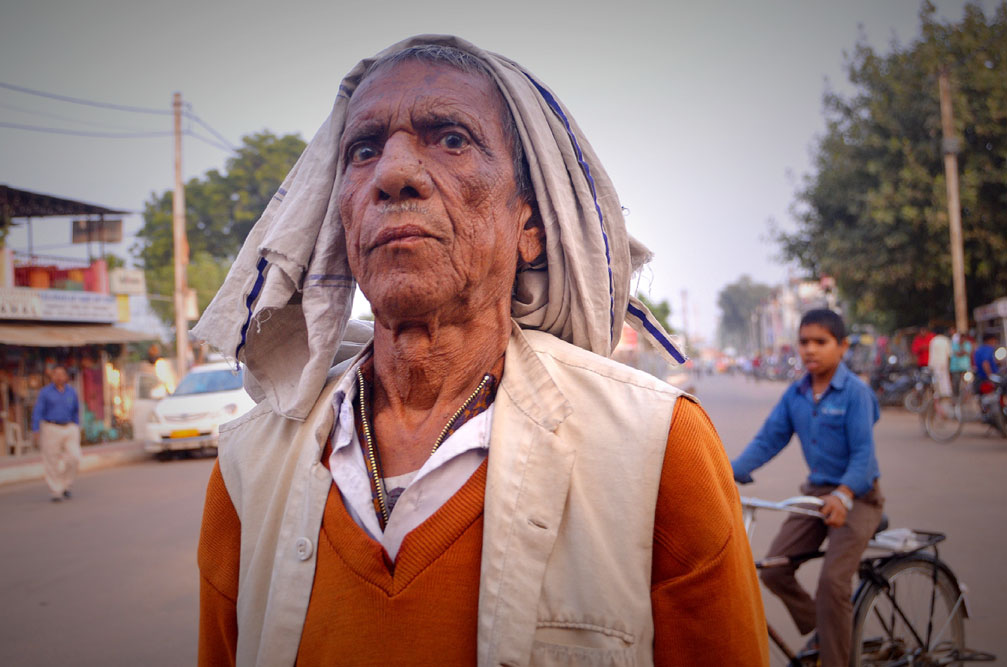
The town has only a few blocks with hawkers trying to lure tourists into their shops. It also has a few cafes serving cappuccinos and surprising a first-rate airport.
Varanasi
Varanasi (also known as Benares) is one of the oldest continuously inhabited cities in the world and possibly the oldest in India. Mark Twain described it as “older than history, older than tradition, older even than legend, and looks twice as old as all of them put together.” It is one of the holiest in Hinduism and is exotic even by Indian standards with swarms of “holy” persons and beggars (often the same, such as the orange-clad Sadhus) and people washing in the polluted Ganges River close to cremation pyres.
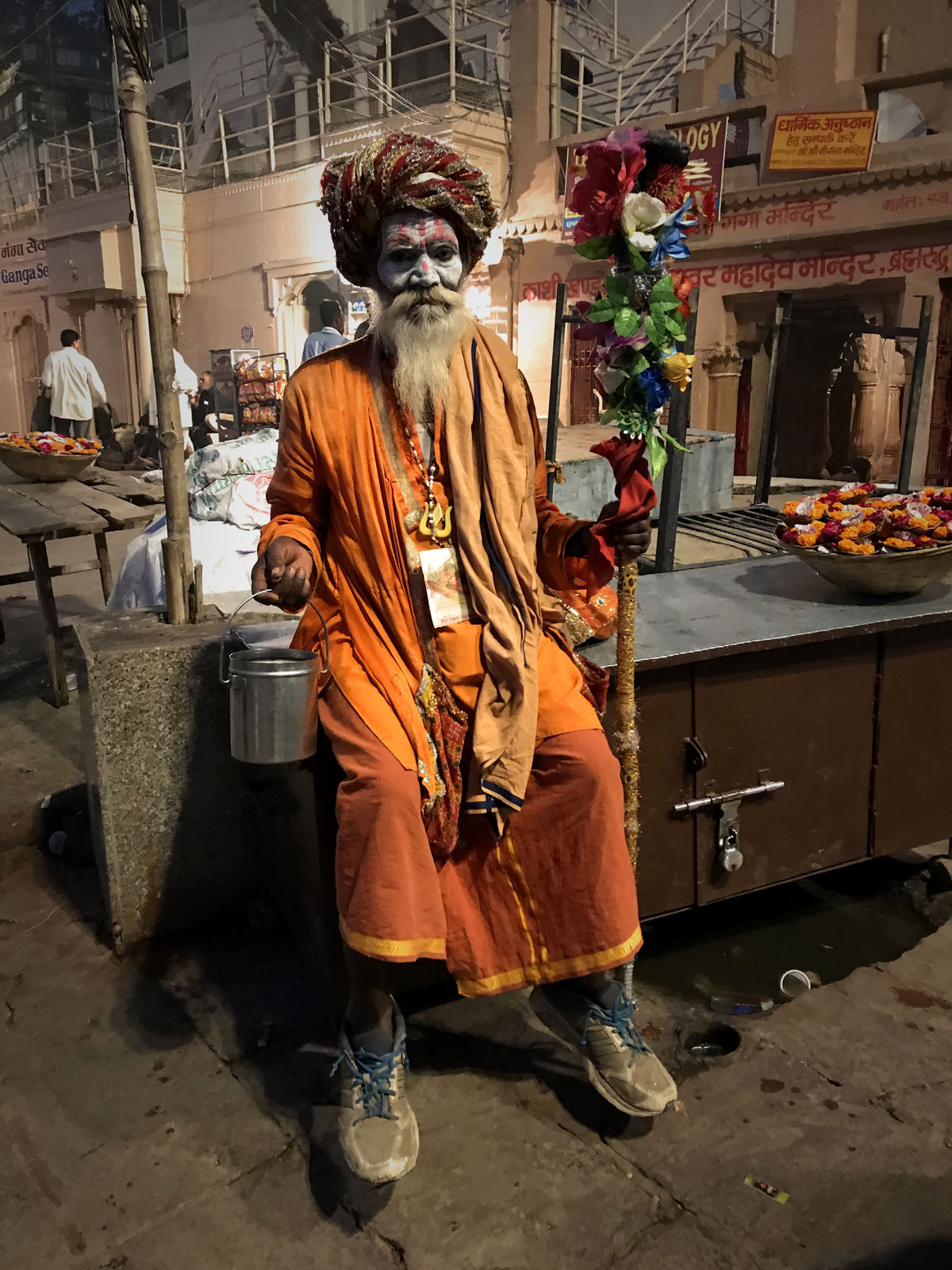
Aarti Ceremony
Aarti is a Hindu fire ceremony performed by Hindu priests in a ritual that dispels darkness. It takes place every night at 7 pm at the Dashashwamedh Ghat (Step) by the Ganges River.
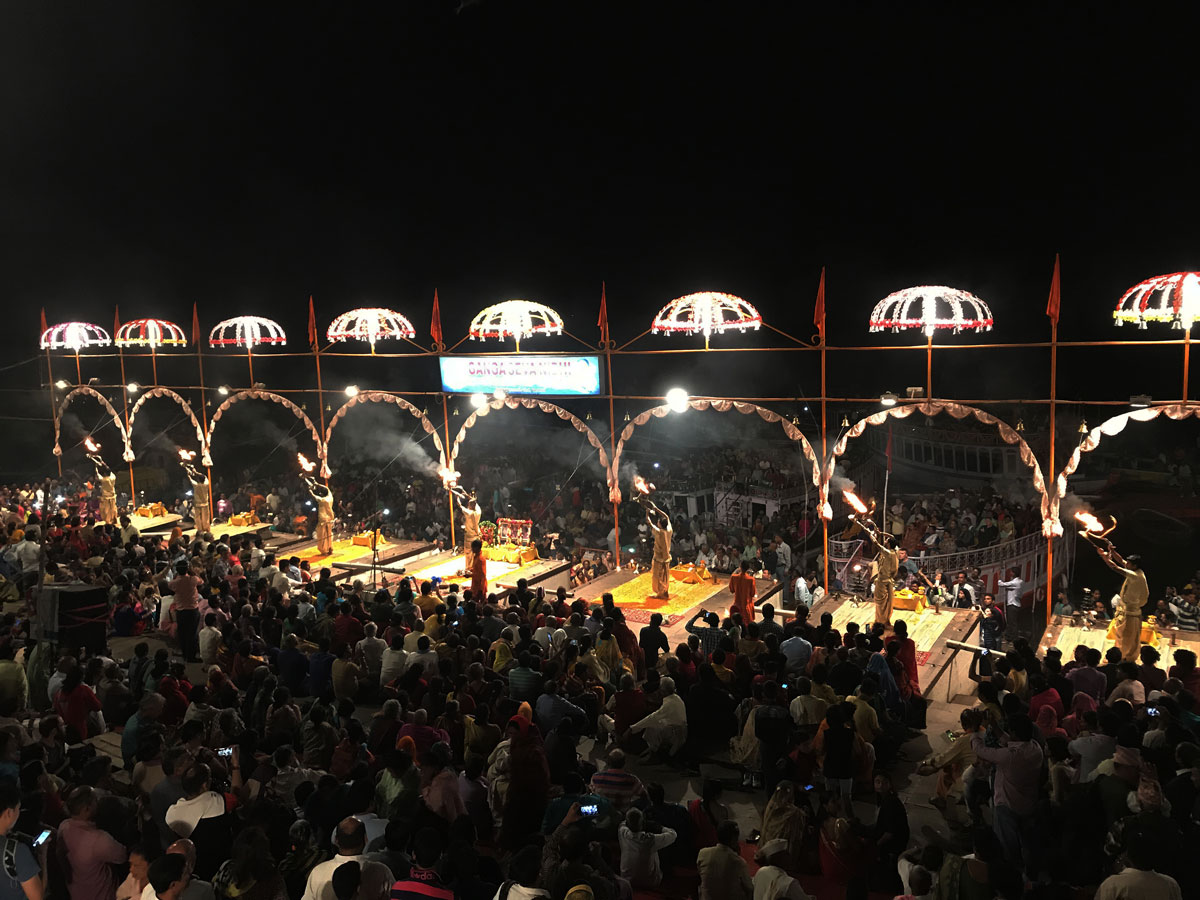
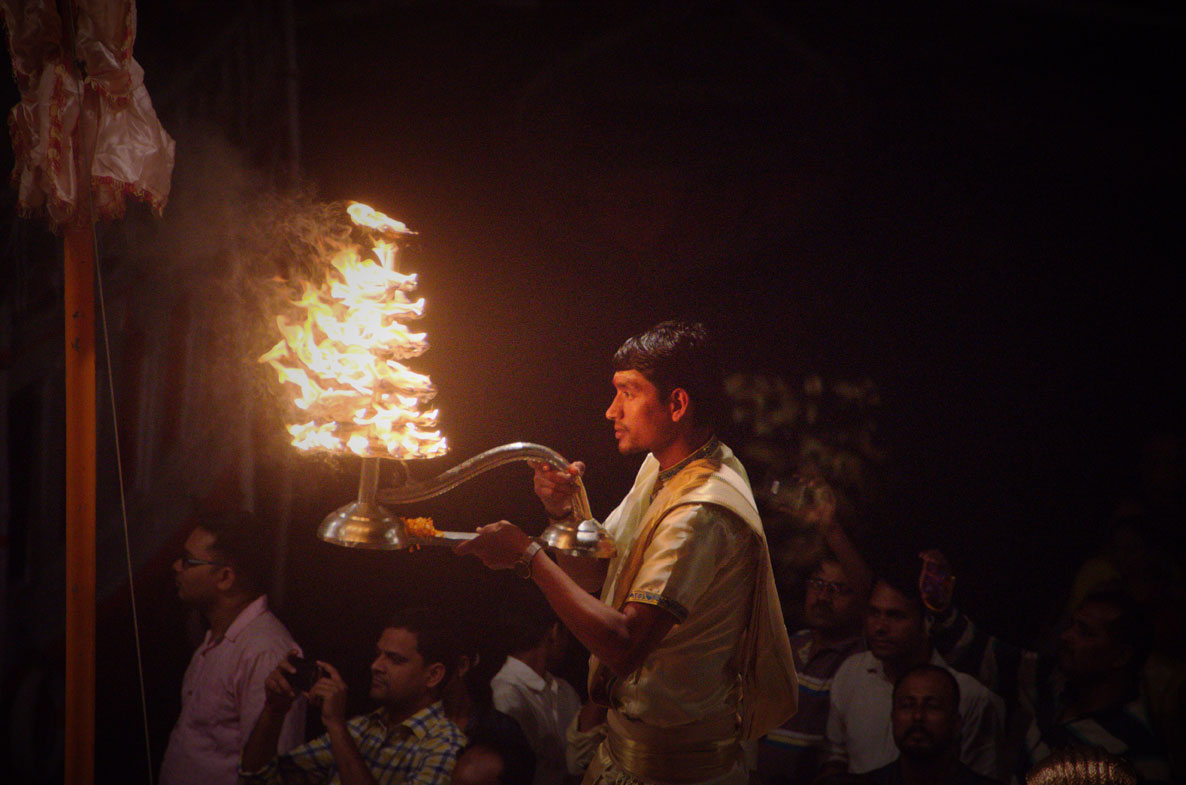
The area is packed with mostly Indians and a sizable number of foreign tourists. While it is a solemn ritual, the atmosphere is circus-like.
Dawn Boat Ride on the Ganges
Our tour provided a rowboat, a rower, and an assistant for our contingent of eleven people plus our local guide. Lit by hazy, early morning sunlight, we observed the visually incredible scenes which take place on the ghats to the Ganges. There are hundreds of people going about their daily work activities, washing in the river or just hanging out amid the fascinating geometric patterns of the waterfront architecture.
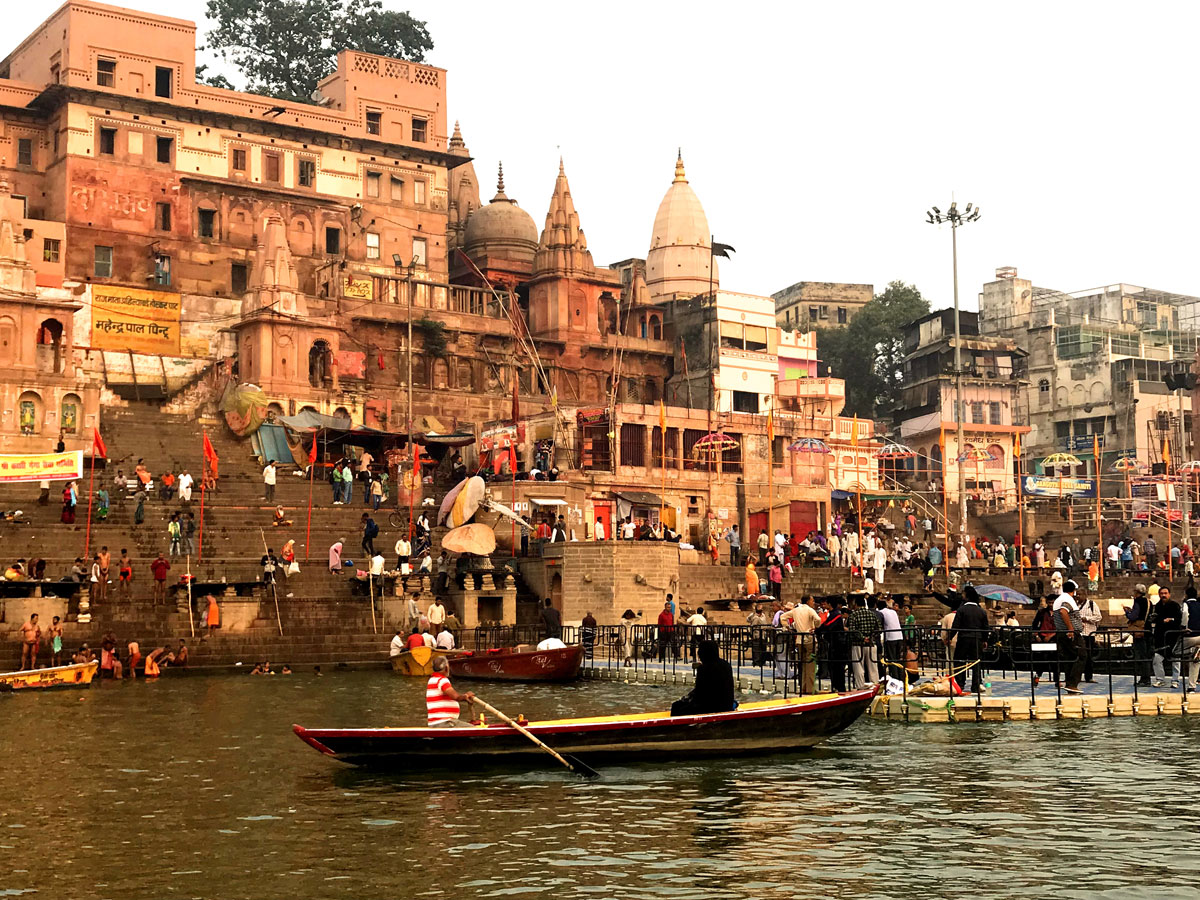
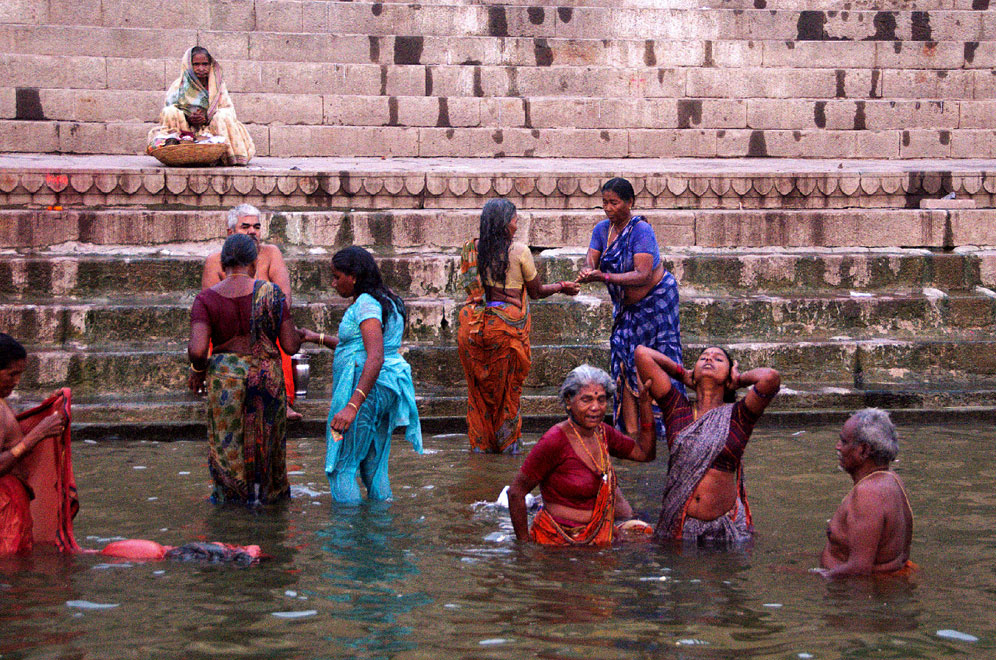
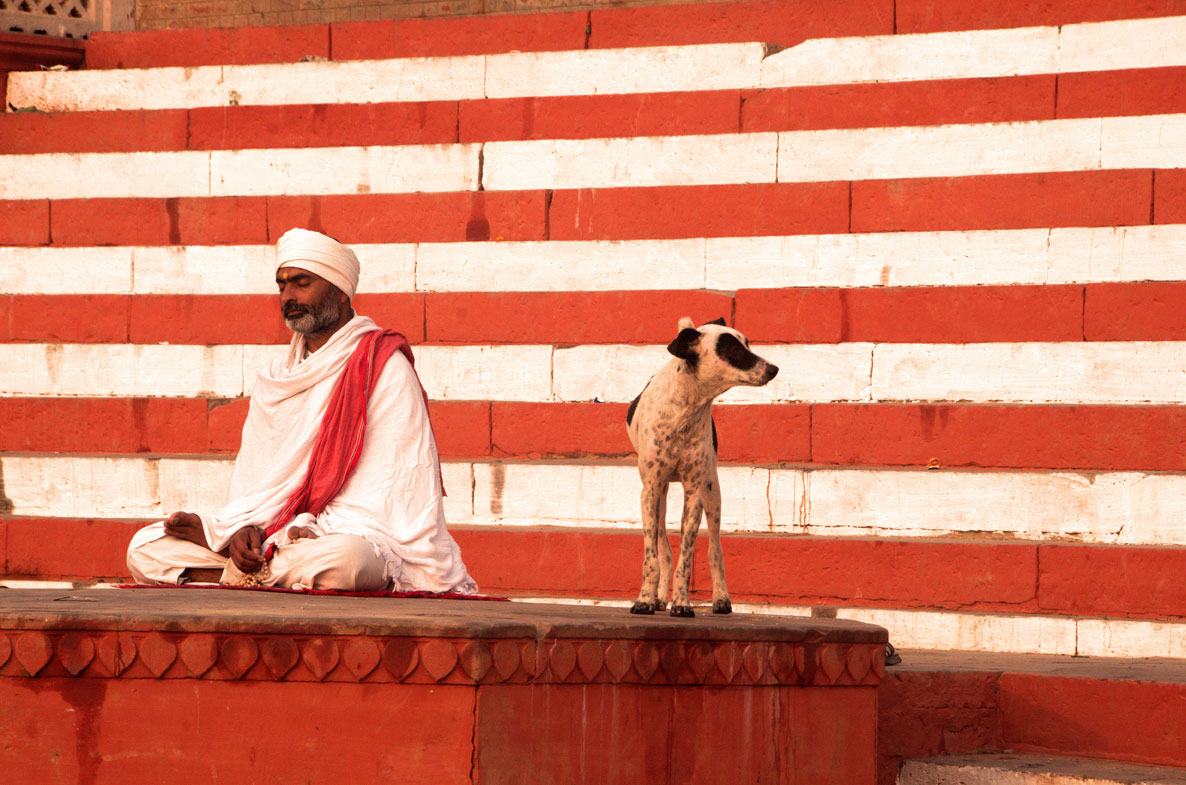
While it cliché, it is really a timeless tableau that I feel quite fortunate to have beheld.
Sarnath
Sarnath is an archeological park located ten kilometers (six miles) from Varanasi. It is the place Buddha delivered his first sermon and is considered the birthplace of Buddhism. It is one of the four most holy sites in Buddhism (the others are Bodh Gaya and Kushinagar (both in India) and Lumbini in Nepal). As a result, there is a constant stream of Buddhist pilgrims coming here.
The park has several small ruins, mostly building foundations, and a large temple and stupa (a dome-shaped structure erected as a Buddhist shrine).
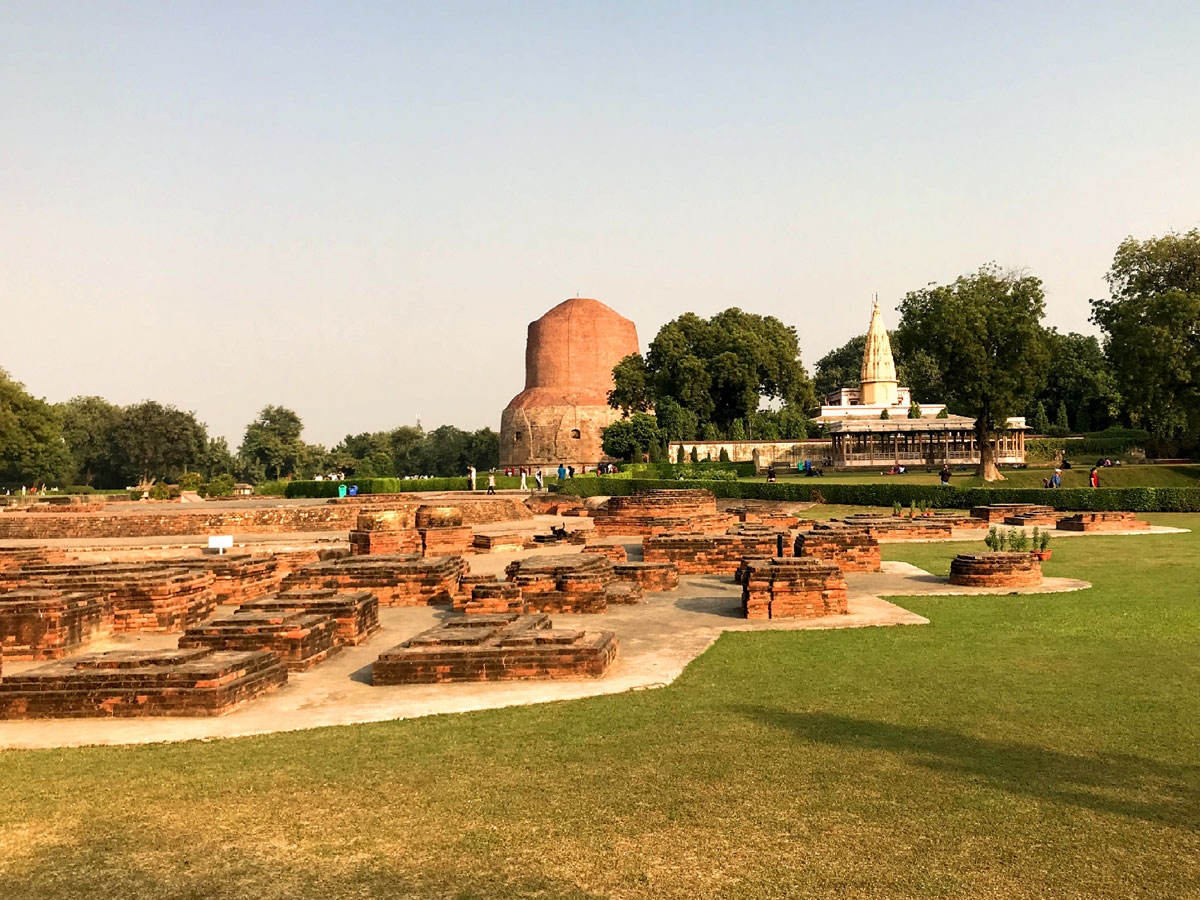
I found the museum to be the most interesting place with a comprehensive collection of Buddhist artifacts. The most prized position is the Lion Capital, which is the basis of the state emblem. The piece has four lions, standing back to back, with other animals and mechanisms surrounding them. It is crowned by the Wheel of the Law. No cameras were allowed, so I have no picture.
Final Thoughts
After writing this, I found it hard to believe we did so much in two weeks. I greatly augmented my understanding of Indian history, culture, and religions, areas I always wanted to learn about in some detail.
While India is a country, it is more analogous to a continent. There is so much to see, to learn and to appreciate, years of travel there would not be enough to know much beyond a superficial level.
As a photographer, it is a beautiful place, with astonishing colorfulness surrounding you always and the wonderful people who embrace their picture being taken (see the Photo Gallery).
My future visits to India will include trips to southern India, Kashmir, various parts of the Himalayas and the Kumbh Mela, which is a massive Hindu pilgrimage in Allahabad.
If anyone has any questions, please contact me!


